Sources of law Legal norm – definition

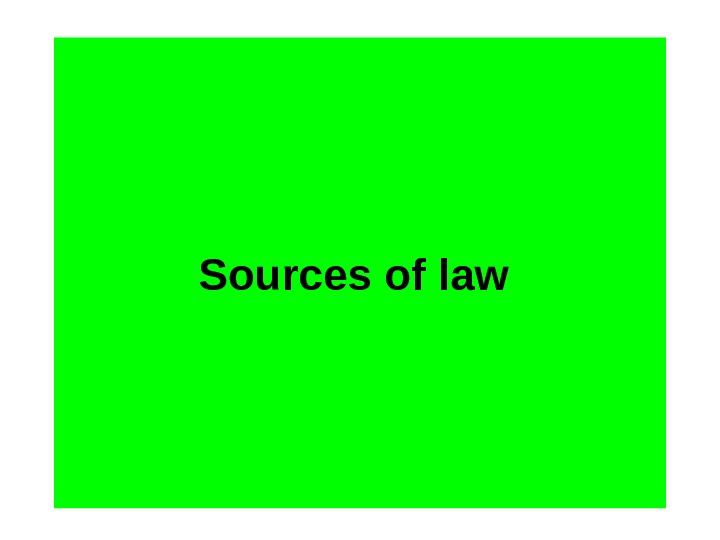
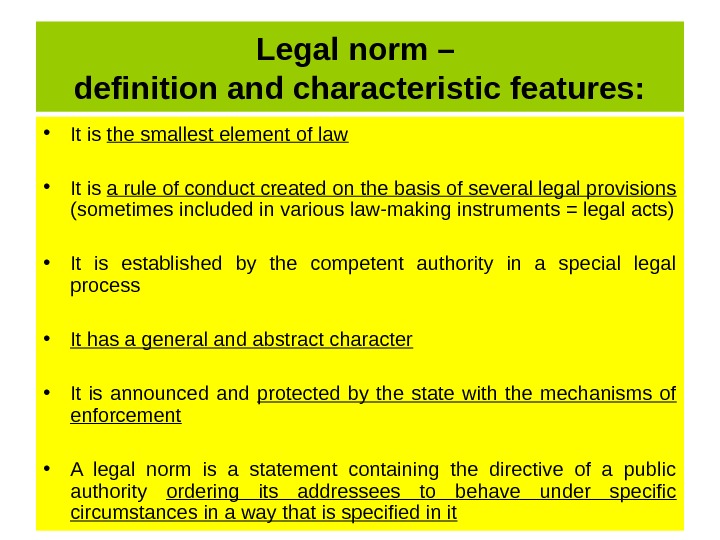
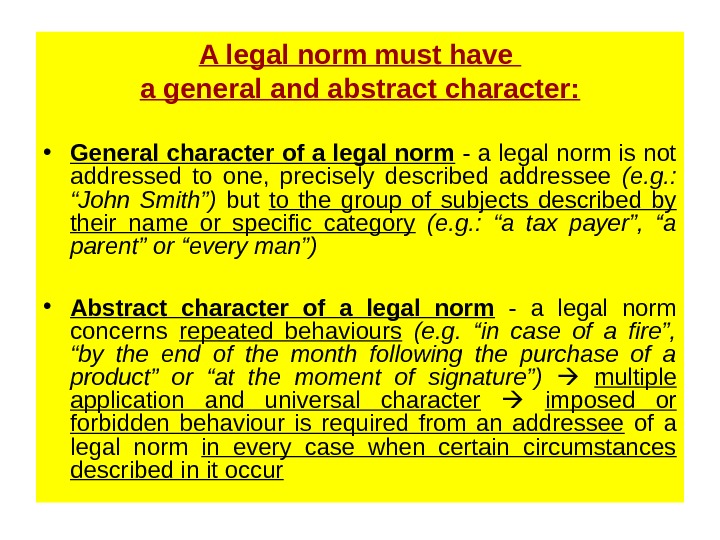
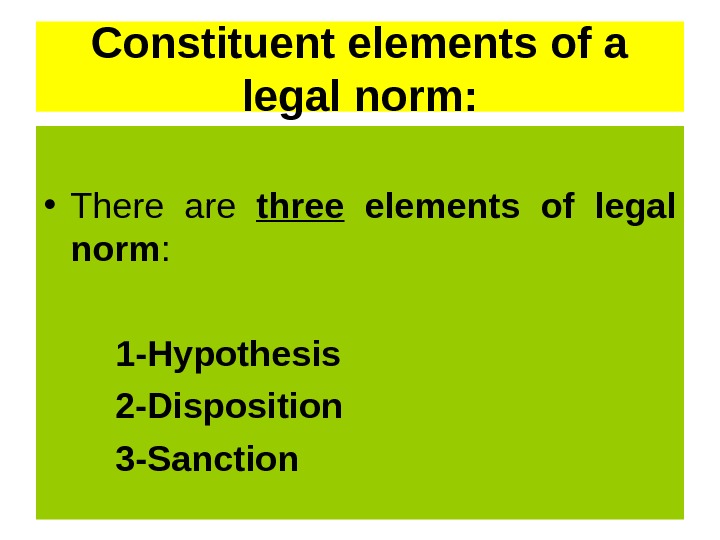
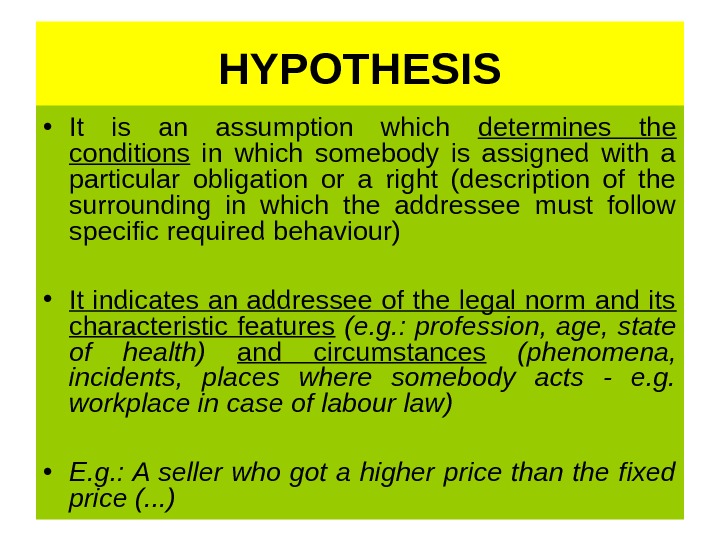
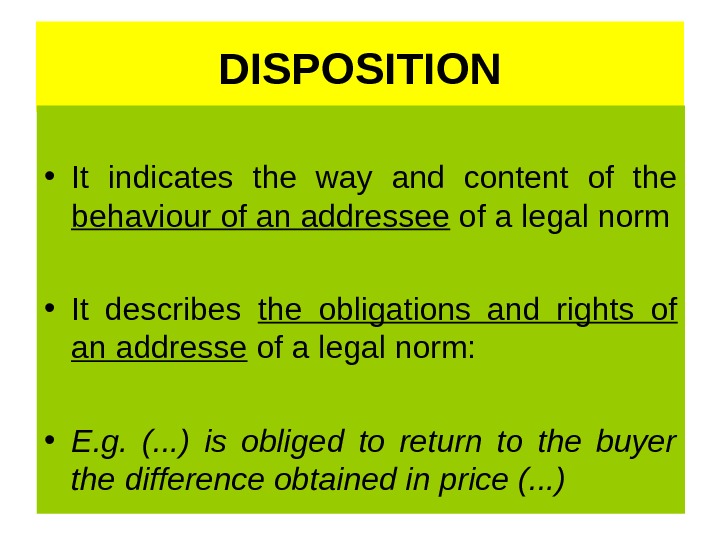
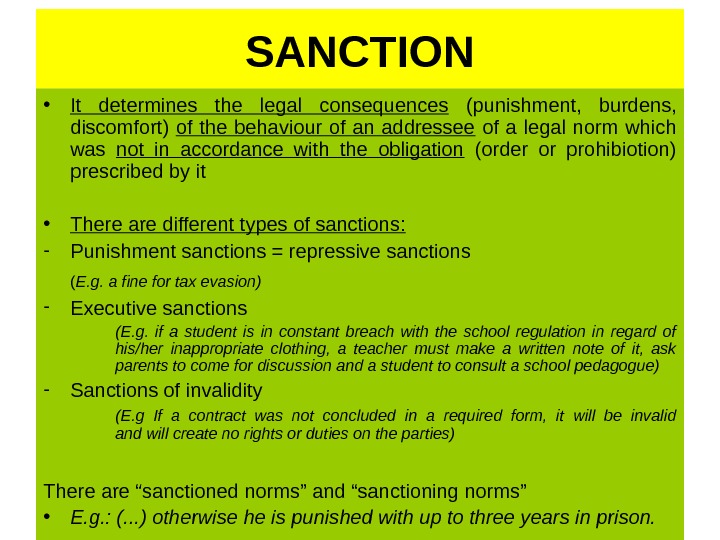
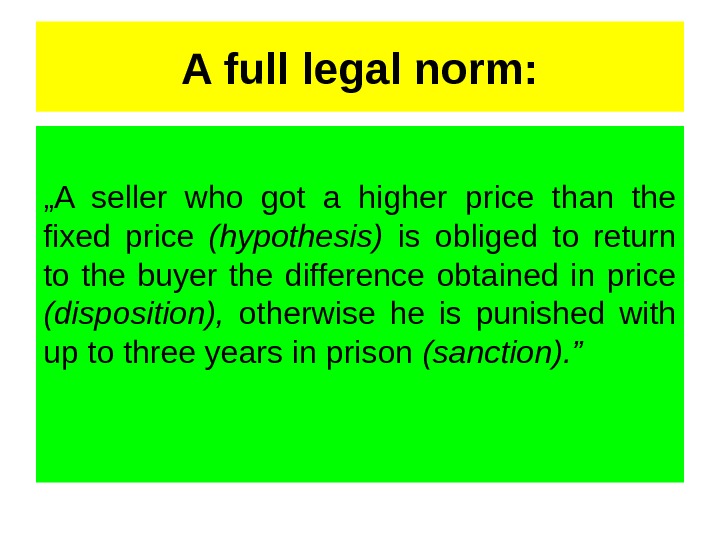
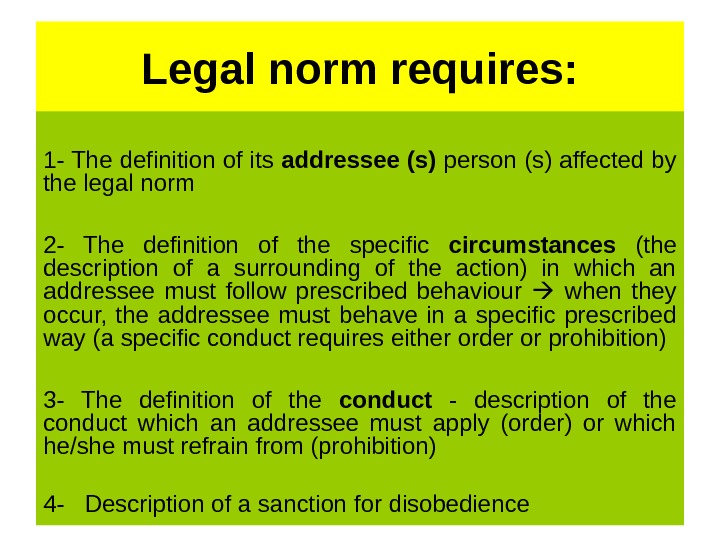
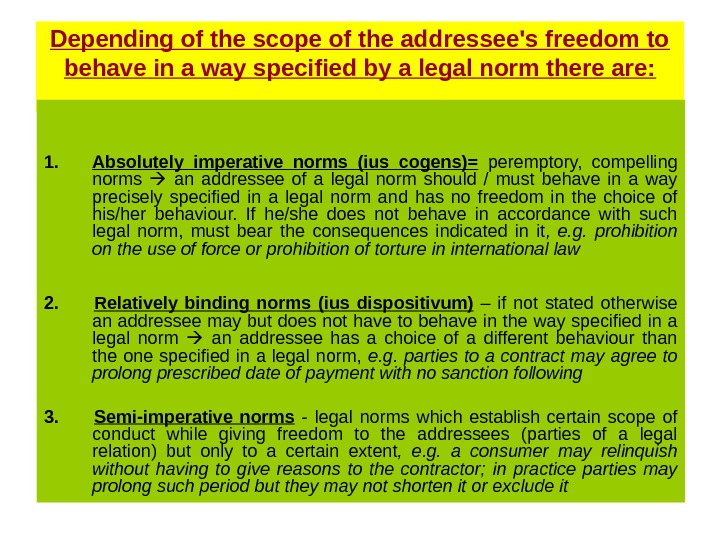

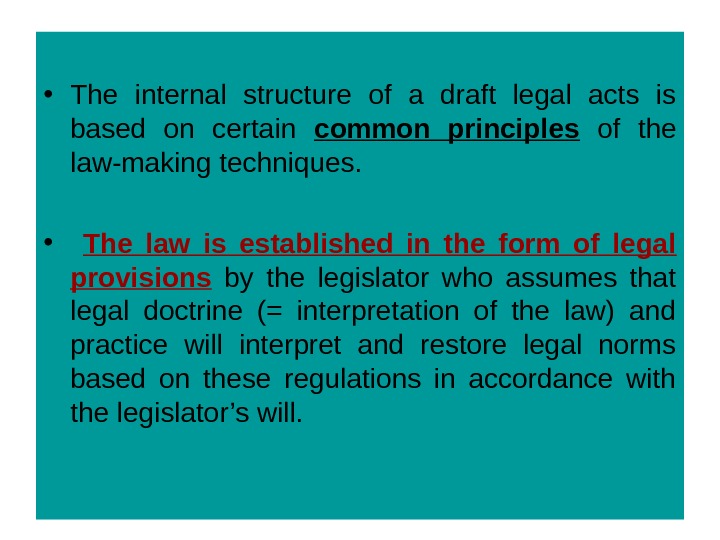
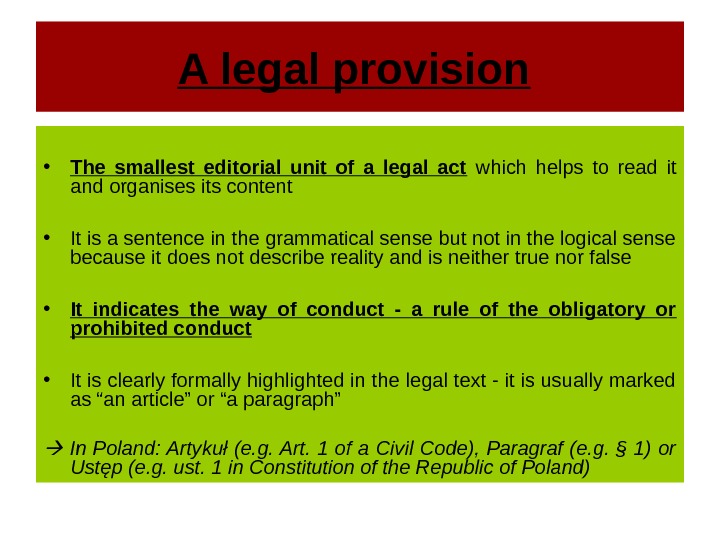
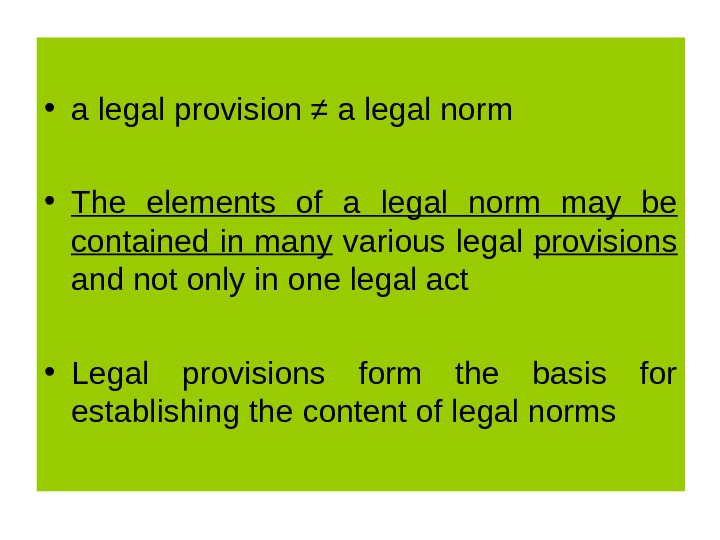
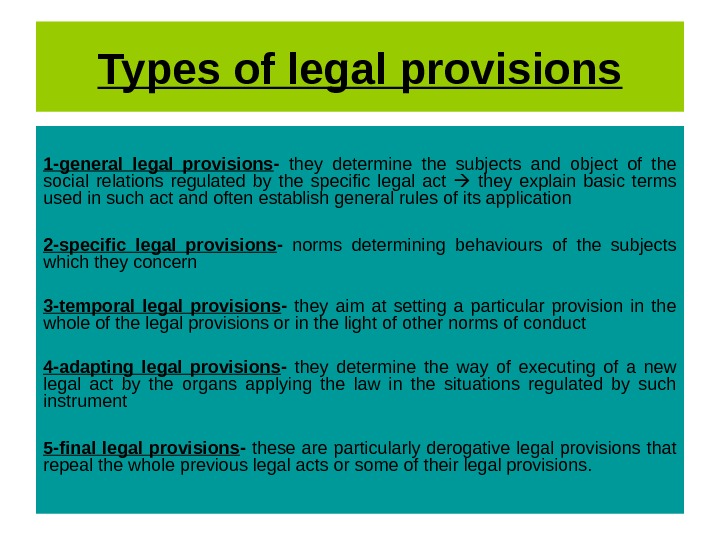
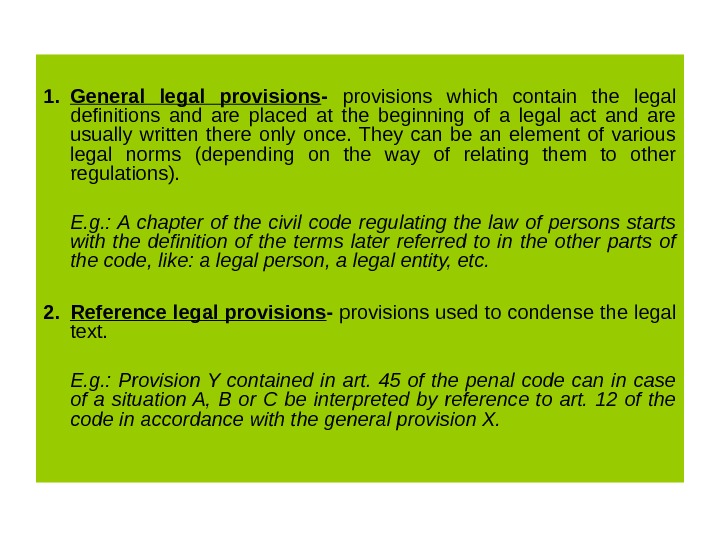
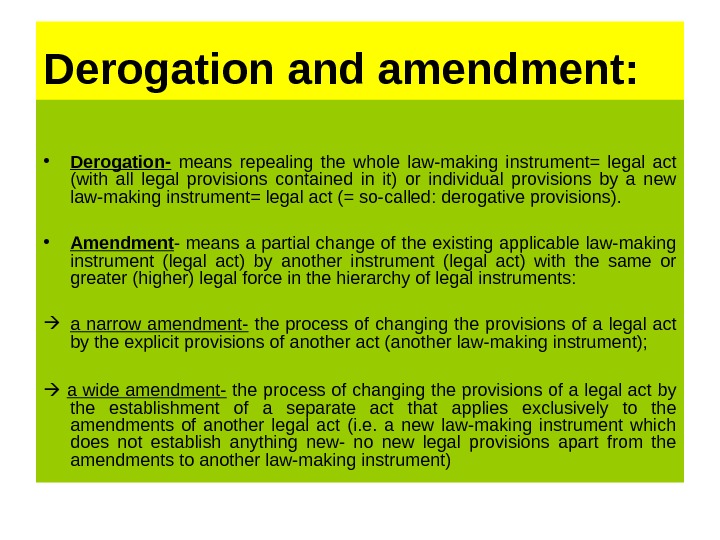
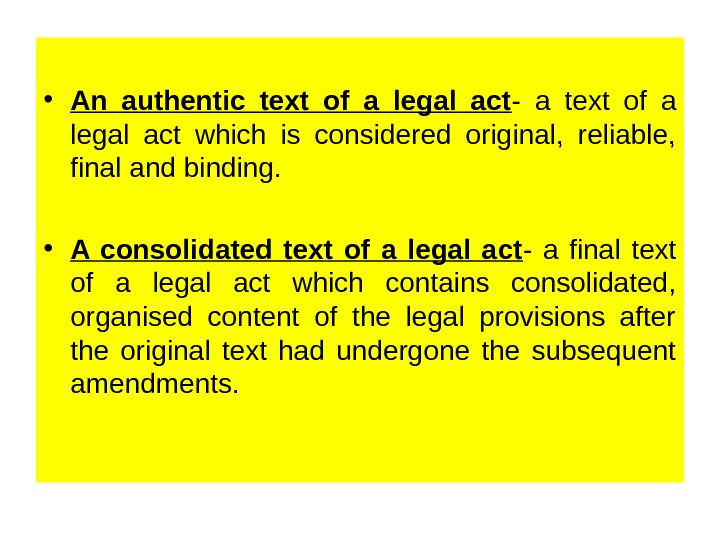
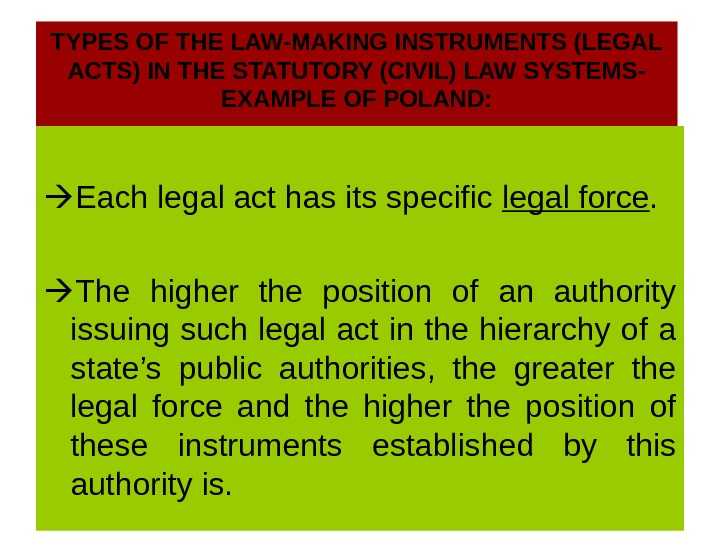
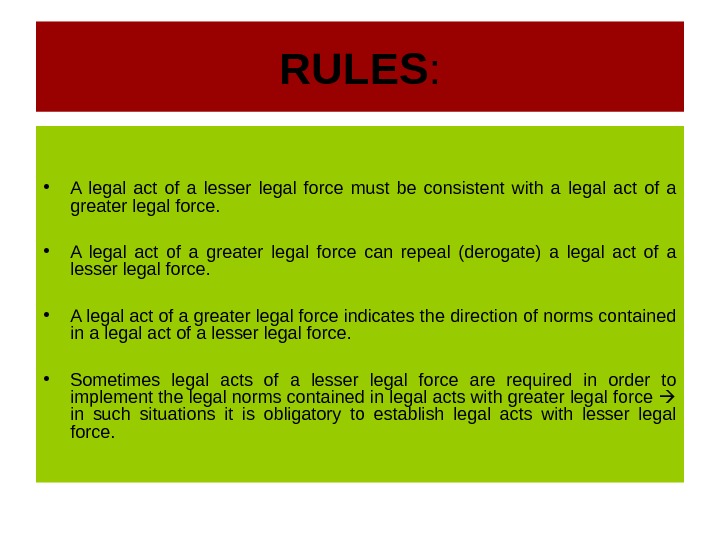
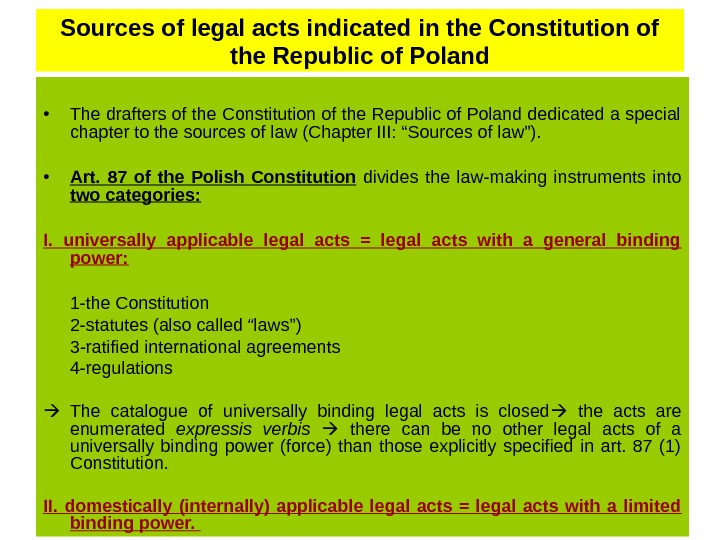
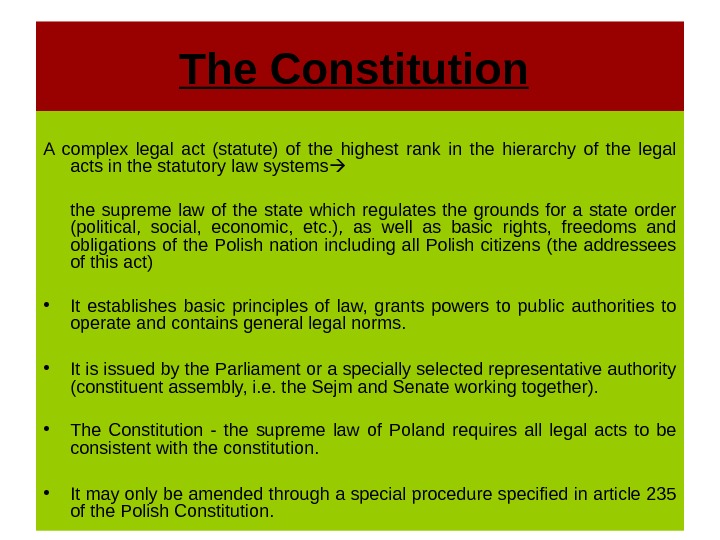
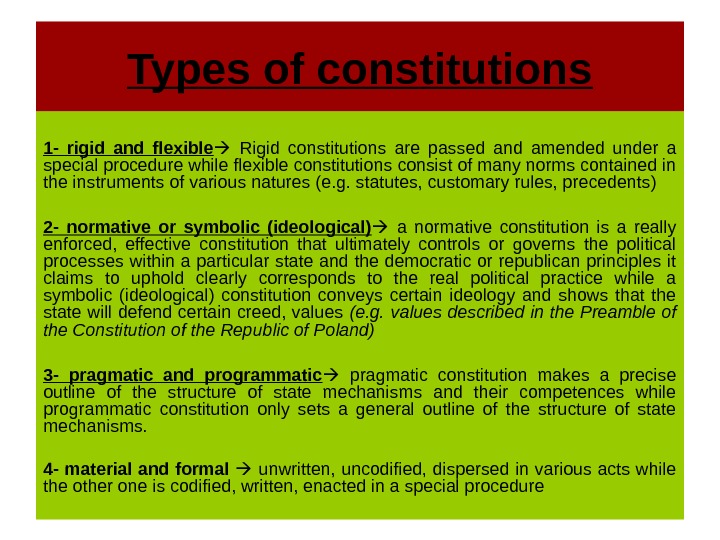
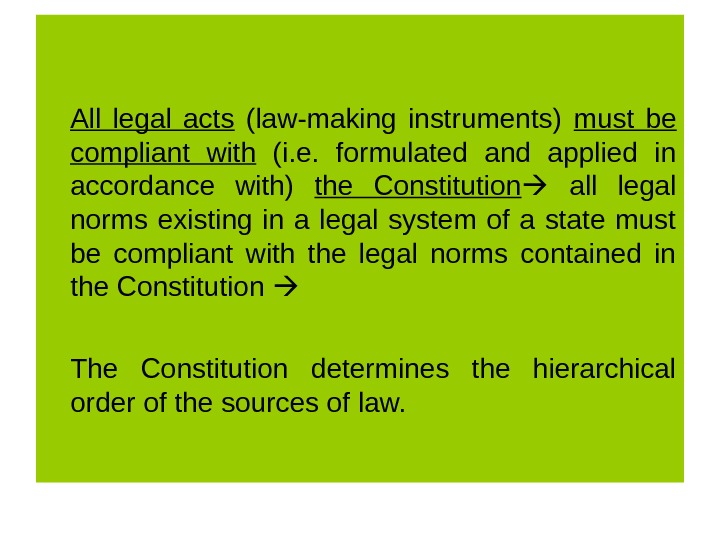
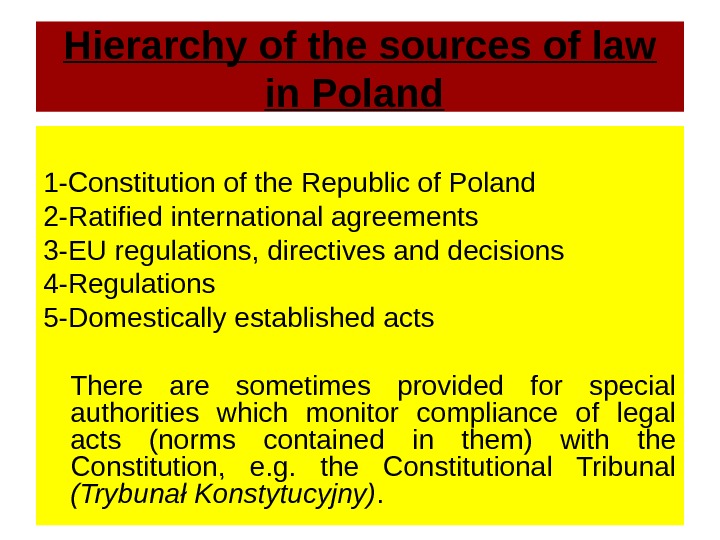
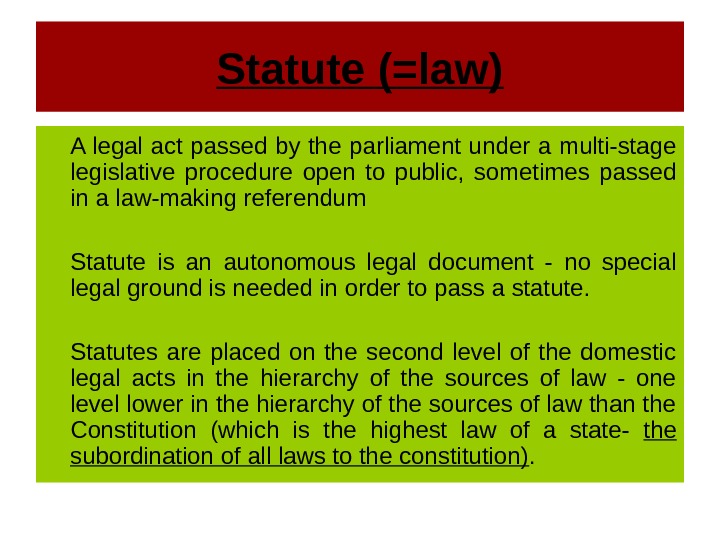
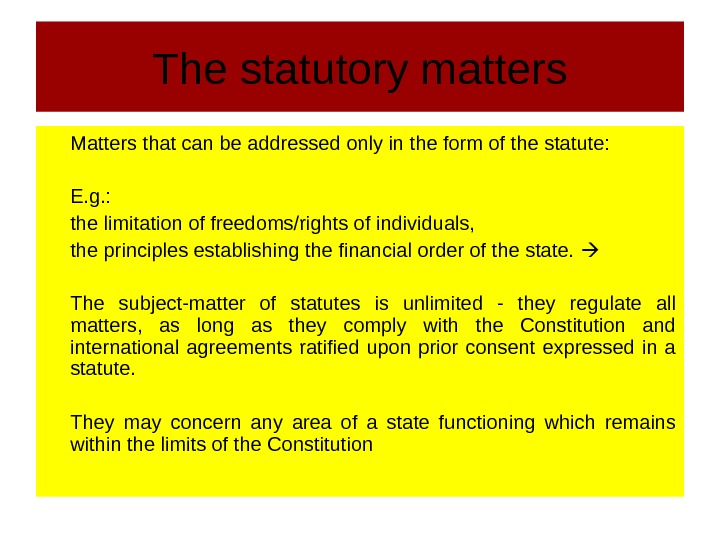
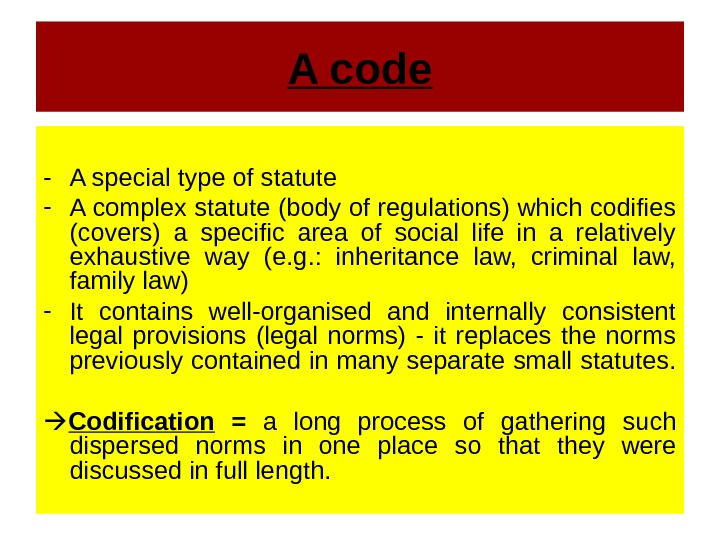
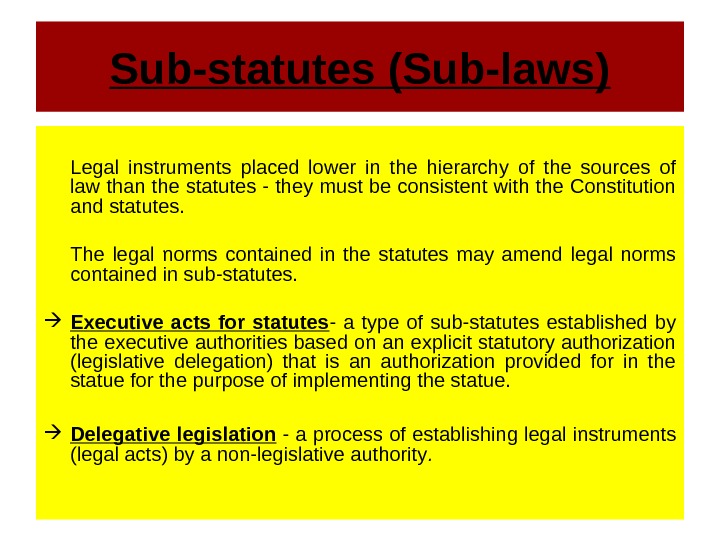
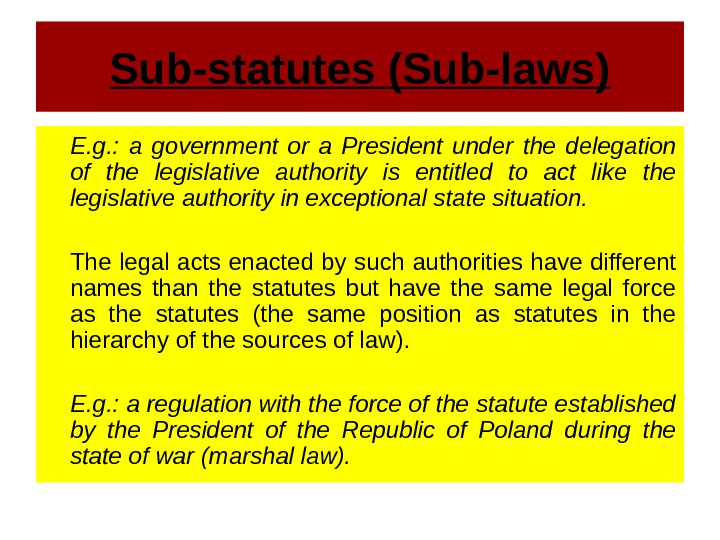
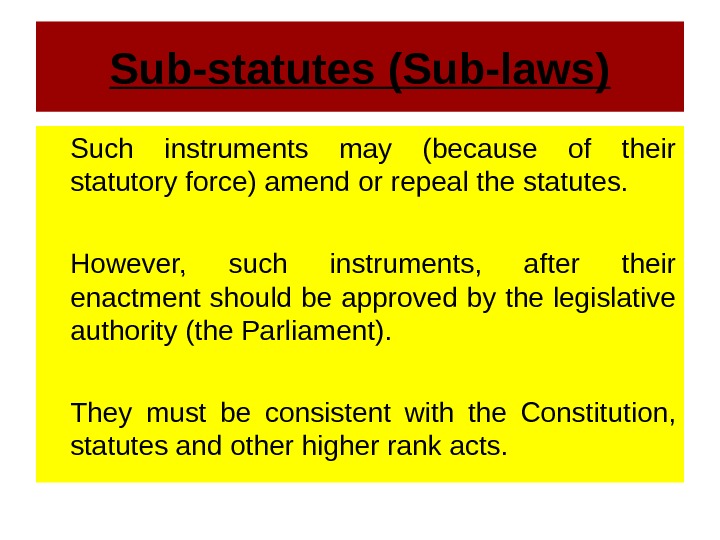
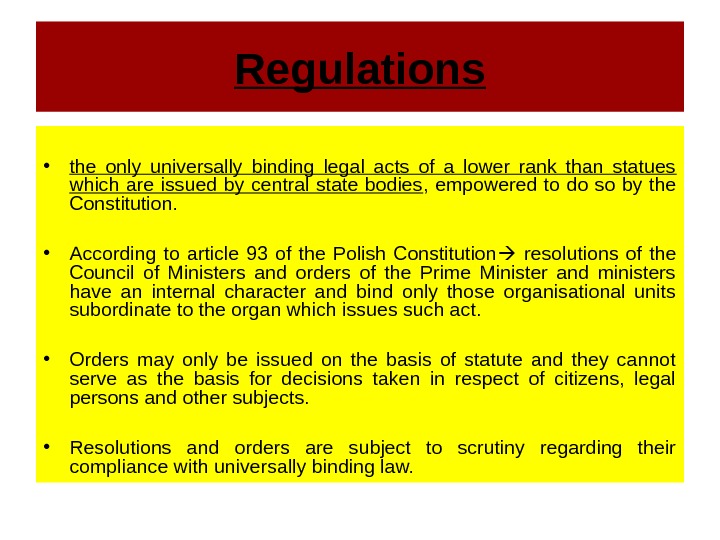
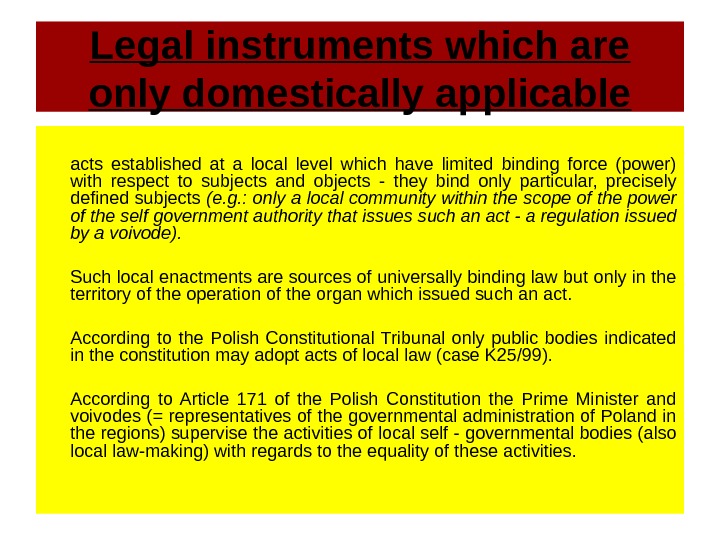
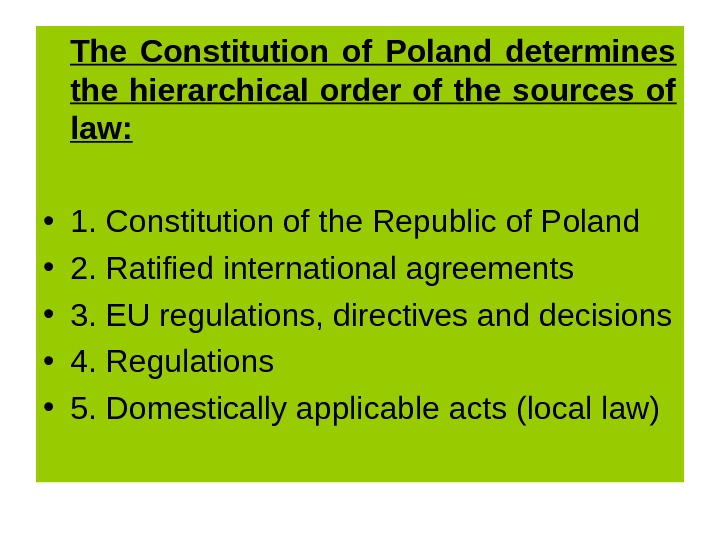
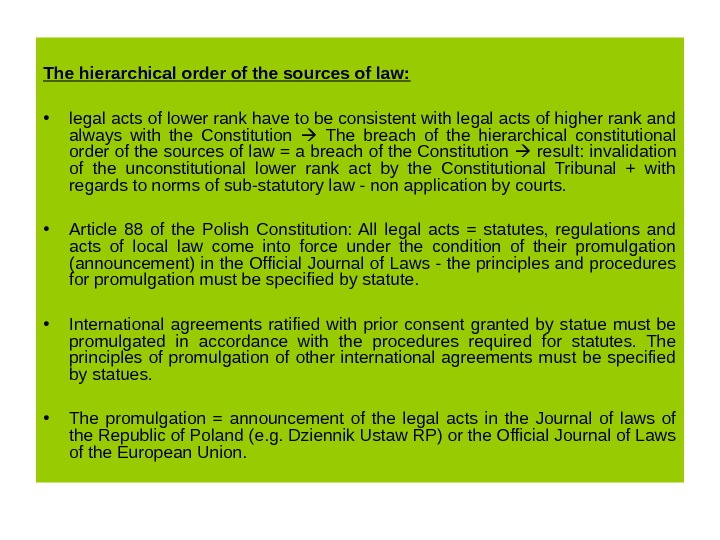
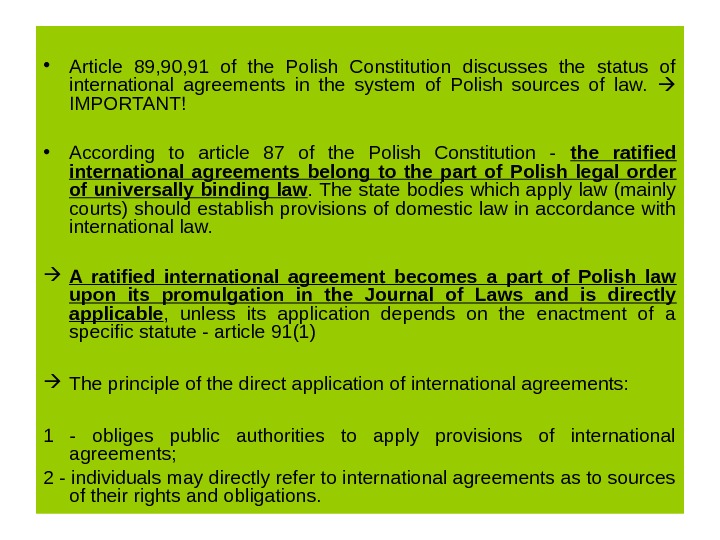
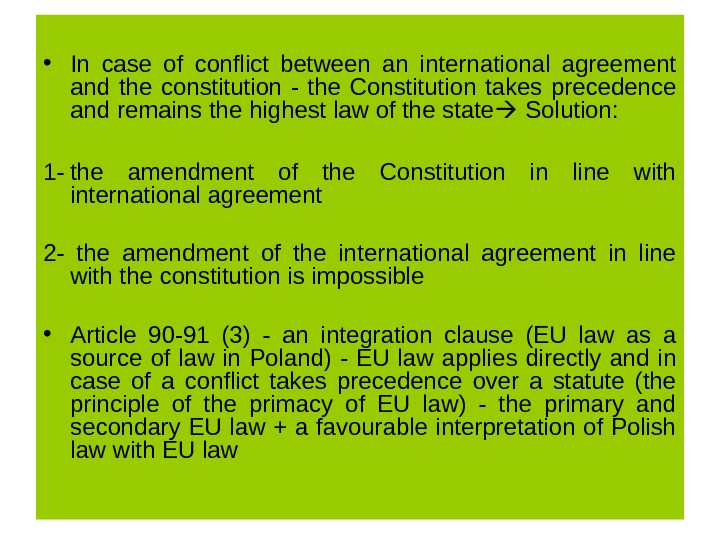
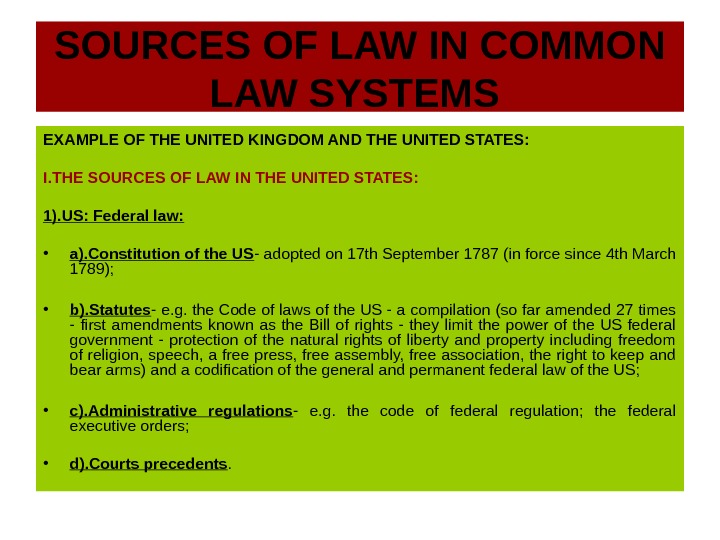
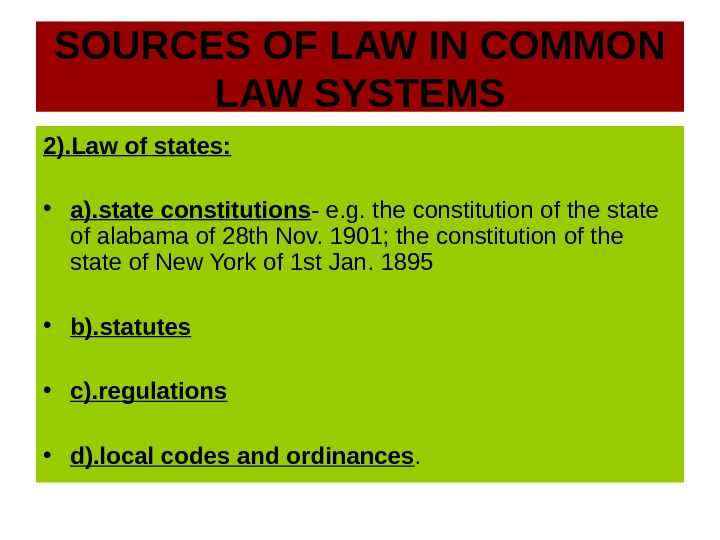
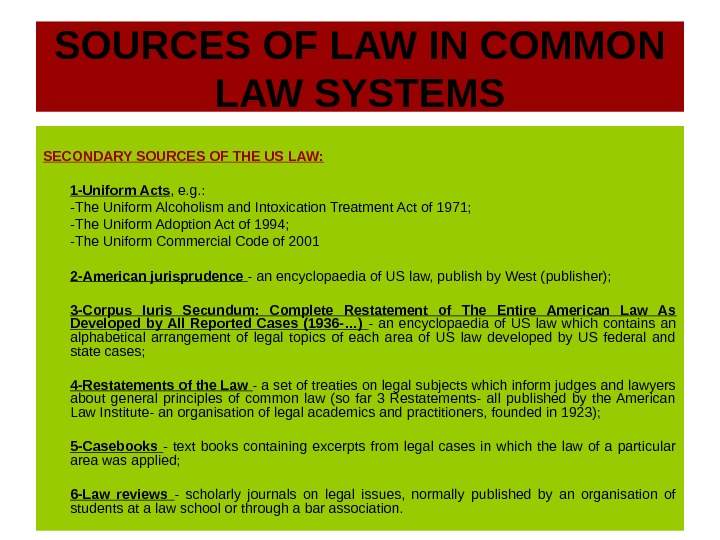
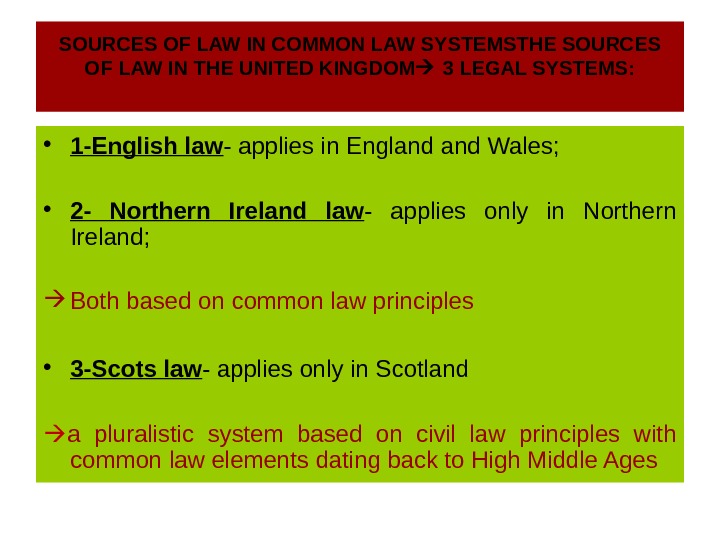

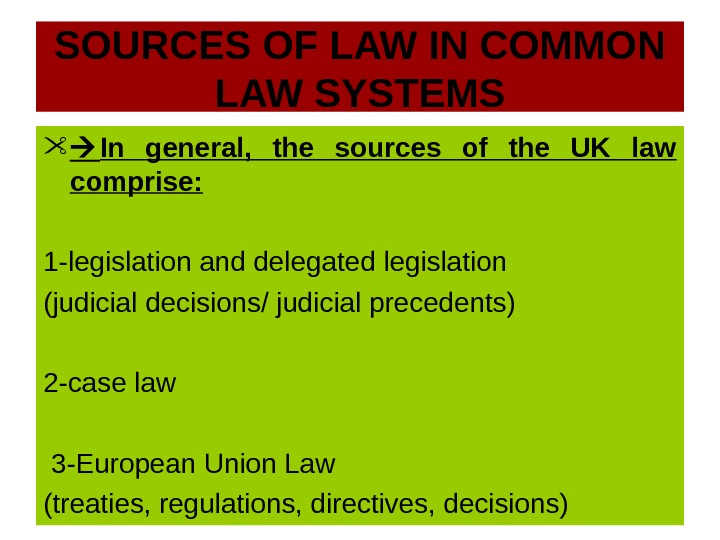
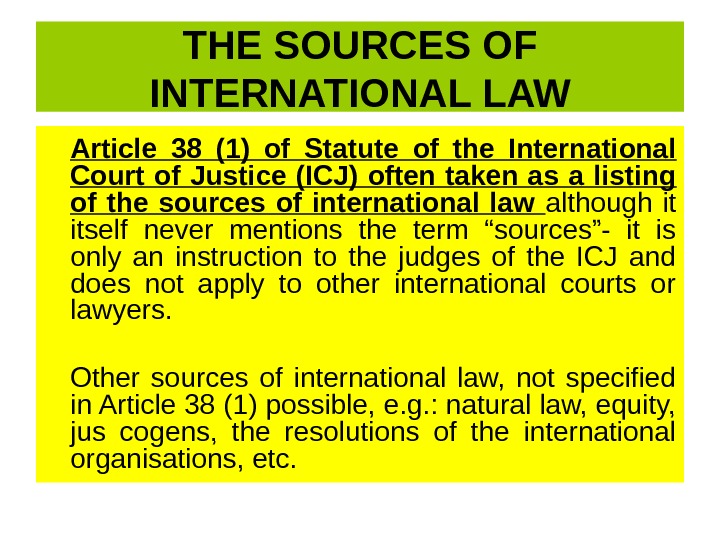
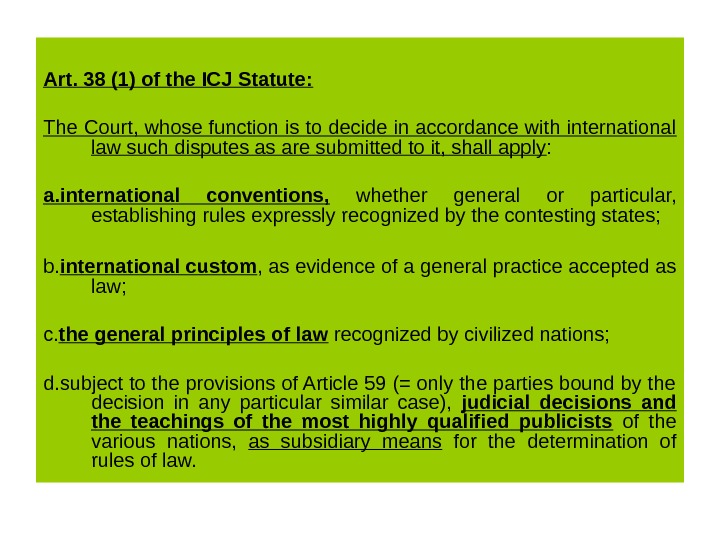
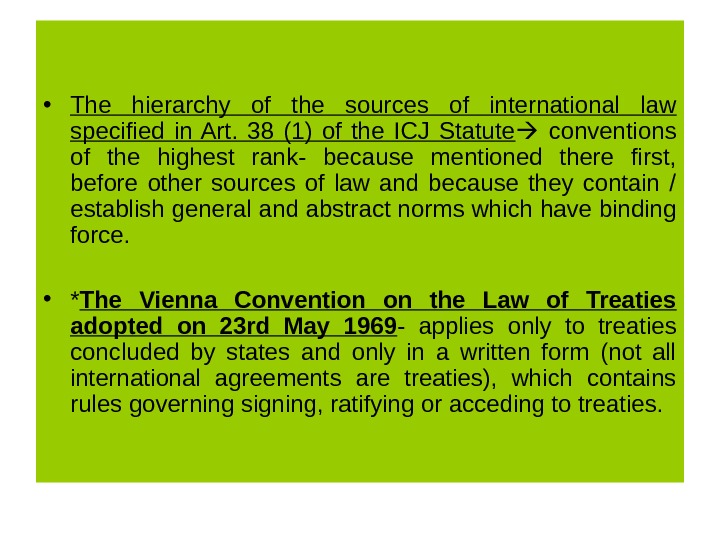
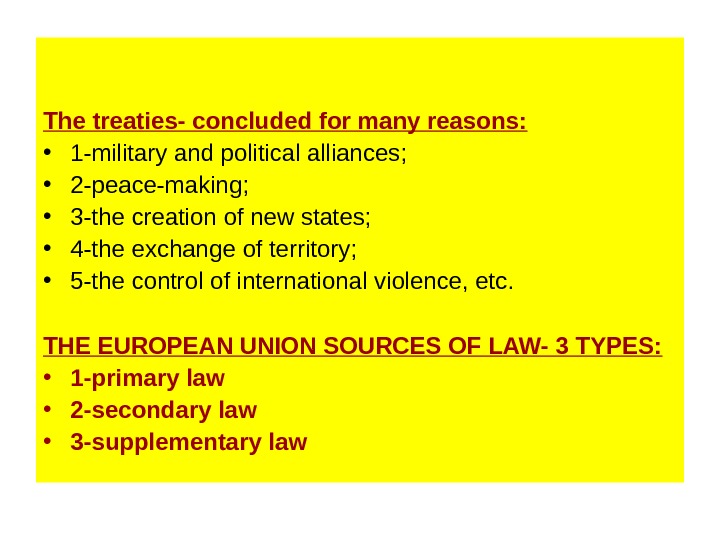
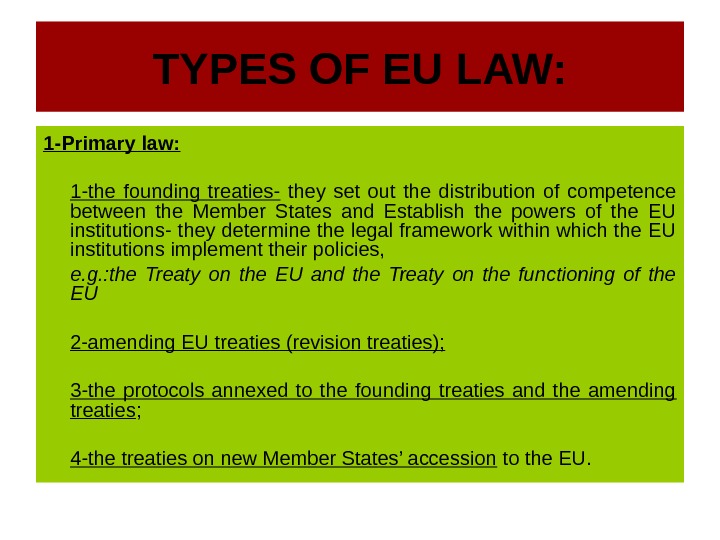
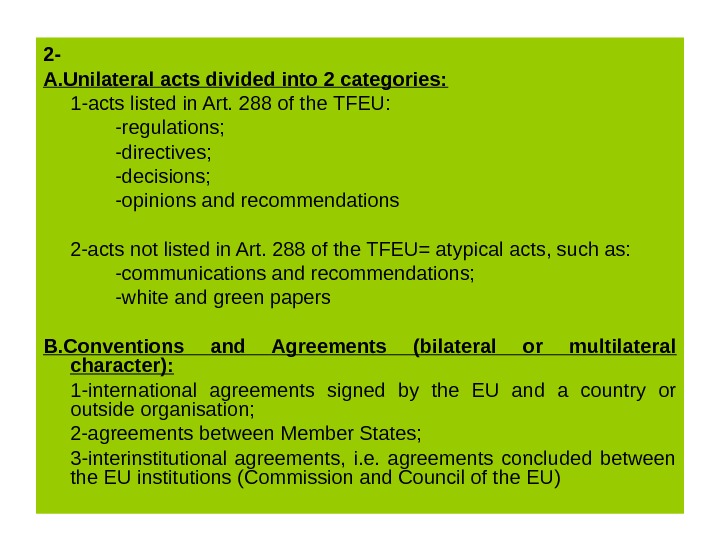
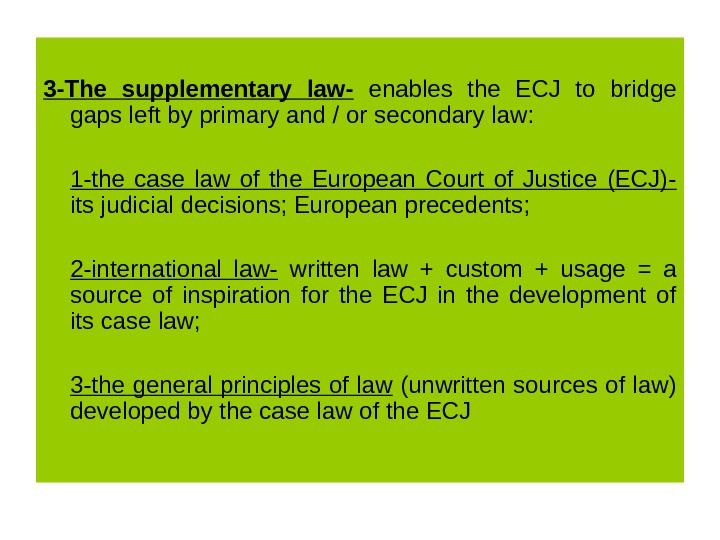
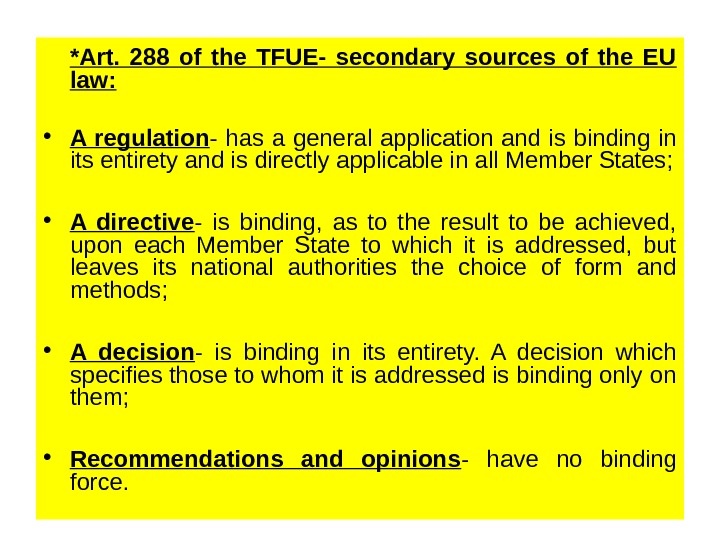
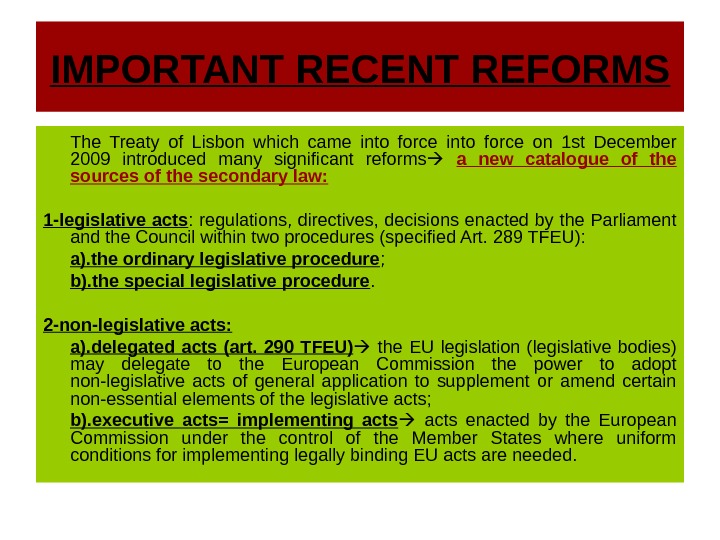
- Размер: 243 Кб
- Количество слайдов: 52
Описание презентации Sources of law Legal norm – definition по слайдам
 Sources of law
Sources of law
 Legal norm – definition and characteristic features: • It is the smallest element of law • It is a rule of conduct created on the basis of several legal provisions (sometimes included in various law-making instruments = legal acts) • It is established by the competent authority in a special legal process • It has a general and abstract character • It is announced and protected by the state with the mechanisms of enforcement • A legal norm is a statement containing the directive of a public authority ordering its addressees to behave under specific circumstances in a way that is specified in it
Legal norm – definition and characteristic features: • It is the smallest element of law • It is a rule of conduct created on the basis of several legal provisions (sometimes included in various law-making instruments = legal acts) • It is established by the competent authority in a special legal process • It has a general and abstract character • It is announced and protected by the state with the mechanisms of enforcement • A legal norm is a statement containing the directive of a public authority ordering its addressees to behave under specific circumstances in a way that is specified in it
 A legal norm must have a general and abstract character: • General character of a legal norm — a legal norm is not addressed to one, precisely described addressee (e. g. : “John Smith”) but to the group of subjects described by their name or specific category (e. g. : “a tax payer”, “a parent” or “every man”) • Abstract character of a legal norm — a legal norm concerns repeated behaviours (e. g. “in case of a fire”, “by the end of the month following the purchase of a product” or “at the moment of signature”) multiple application and universal character imposed or forbidden behaviour is required from an addressee of a legal norm in every case when certain circumstances described in it occur
A legal norm must have a general and abstract character: • General character of a legal norm — a legal norm is not addressed to one, precisely described addressee (e. g. : “John Smith”) but to the group of subjects described by their name or specific category (e. g. : “a tax payer”, “a parent” or “every man”) • Abstract character of a legal norm — a legal norm concerns repeated behaviours (e. g. “in case of a fire”, “by the end of the month following the purchase of a product” or “at the moment of signature”) multiple application and universal character imposed or forbidden behaviour is required from an addressee of a legal norm in every case when certain circumstances described in it occur
 Constituent elements of a legal norm: • There are three elements of legal norm : 1 -Hypothesis 2 -Disposition 3 -Sanction
Constituent elements of a legal norm: • There are three elements of legal norm : 1 -Hypothesis 2 -Disposition 3 -Sanction
 HYPOTHESIS • It is an assumption which determines the conditions in which somebody is assigned with a particular obligation or a right (description of the surrounding in which the addressee must follow specific required behaviour) • It indicates an addressee of the legal norm and its characteristic features (e. g. : profession, age, state of health) and circumstances (phenomena, incidents, places where somebody acts — e. g. workplace in case of labour law) • E. g. : A seller who got a higher price than the fixed price (. . . )
HYPOTHESIS • It is an assumption which determines the conditions in which somebody is assigned with a particular obligation or a right (description of the surrounding in which the addressee must follow specific required behaviour) • It indicates an addressee of the legal norm and its characteristic features (e. g. : profession, age, state of health) and circumstances (phenomena, incidents, places where somebody acts — e. g. workplace in case of labour law) • E. g. : A seller who got a higher price than the fixed price (. . . )
 DISPOSITION • It indicates the way and content of the behaviour of an addressee of a legal norm • It describes the obligations and rights of an addresse of a legal norm: • E. g. (. . . ) is obliged to return to the buyer the difference obtained in price (. . . )
DISPOSITION • It indicates the way and content of the behaviour of an addressee of a legal norm • It describes the obligations and rights of an addresse of a legal norm: • E. g. (. . . ) is obliged to return to the buyer the difference obtained in price (. . . )
 SANCTION • It determines the legal consequences (punishment, burdens, discomfort) of the behaviour of an addressee of a legal norm which was not in accordance with the obligation (order or prohibiotion) prescribed by it • There are different types of sanctions: — Punishment sanctions = repressive sanctions ( E. g. a fine for tax evasion) — Executive sanctions (E. g. if a student is in constant breach with the school regulation in regard of his/her inappropriate clothing, a teacher must make a written note of it, ask parents to come for discussion and a student to consult a school pedagogue) — Sanctions of invalidity (E. g If a contract was not concluded in a required form, it will be invalid and will create no rights or duties on the parties) There are “sanctioned norms” and “sanctioning norms” • E. g. : (. . . ) otherwise he is punished with up to three years in prison.
SANCTION • It determines the legal consequences (punishment, burdens, discomfort) of the behaviour of an addressee of a legal norm which was not in accordance with the obligation (order or prohibiotion) prescribed by it • There are different types of sanctions: — Punishment sanctions = repressive sanctions ( E. g. a fine for tax evasion) — Executive sanctions (E. g. if a student is in constant breach with the school regulation in regard of his/her inappropriate clothing, a teacher must make a written note of it, ask parents to come for discussion and a student to consult a school pedagogue) — Sanctions of invalidity (E. g If a contract was not concluded in a required form, it will be invalid and will create no rights or duties on the parties) There are “sanctioned norms” and “sanctioning norms” • E. g. : (. . . ) otherwise he is punished with up to three years in prison.
 A full legal norm: „ A seller who got a higher price than the fixed price (hypothesis) is obliged to return to the buyer the difference obtained in price (disposition), otherwise he is punished with up to three years in prison (sanction). ”
A full legal norm: „ A seller who got a higher price than the fixed price (hypothesis) is obliged to return to the buyer the difference obtained in price (disposition), otherwise he is punished with up to three years in prison (sanction). ”
 Legal norm requires: 1 — The definition of its addressee (s) person (s) affected by the legal norm 2 — The definition of the specific circumstances (the description of a surrounding of the action) in which an addressee must follow prescribed behaviour when they occur, the addressee must behave in a specific prescribed way (a specific conduct requires either order or prohibition) 3 — The definition of the conduct — description of the conduct which an addressee must apply (order) or which he/she must refrain from (prohibition) 4 — Description of a sanction for disobedience
Legal norm requires: 1 — The definition of its addressee (s) person (s) affected by the legal norm 2 — The definition of the specific circumstances (the description of a surrounding of the action) in which an addressee must follow prescribed behaviour when they occur, the addressee must behave in a specific prescribed way (a specific conduct requires either order or prohibition) 3 — The definition of the conduct — description of the conduct which an addressee must apply (order) or which he/she must refrain from (prohibition) 4 — Description of a sanction for disobedience
 Depending of the scope of the addressee’s freedom to behave in a way specified by a legal norm there are: 1. Absolutely imperative norms (ius cogens)= peremptory, compelling norms an addressee of a legal norm should / must behave in a way precisely specified in a legal norm and has no freedom in the choice of his/her behaviour. If he/she does not behave in accordance with such legal norm, must bear the consequences indicated in it, e. g. prohibition on the use of force or prohibition of torture in international law 2. Relatively binding norms (ius dispositivum) – if not stated otherwise an addressee may but does not have to behave in the way specified in a legal norm an addressee has a choice of a different behaviour than the one specified in a legal norm, e. g. parties to a contract may agree to prolong prescribed date of payment with no sanction following 3. Semi-imperative norms — legal norms which establish certain scope of conduct while giving freedom to the addressees (parties of a legal relation) but only to a certain extent , e. g. a consumer may relinquish without having to give reasons to the contractor; in practice parties may prolong such period but they may not shorten it or exclude it
Depending of the scope of the addressee’s freedom to behave in a way specified by a legal norm there are: 1. Absolutely imperative norms (ius cogens)= peremptory, compelling norms an addressee of a legal norm should / must behave in a way precisely specified in a legal norm and has no freedom in the choice of his/her behaviour. If he/she does not behave in accordance with such legal norm, must bear the consequences indicated in it, e. g. prohibition on the use of force or prohibition of torture in international law 2. Relatively binding norms (ius dispositivum) – if not stated otherwise an addressee may but does not have to behave in the way specified in a legal norm an addressee has a choice of a different behaviour than the one specified in a legal norm, e. g. parties to a contract may agree to prolong prescribed date of payment with no sanction following 3. Semi-imperative norms — legal norms which establish certain scope of conduct while giving freedom to the addressees (parties of a legal relation) but only to a certain extent , e. g. a consumer may relinquish without having to give reasons to the contractor; in practice parties may prolong such period but they may not shorten it or exclude it
 Depending on the way of the description of people’s behaviour there are: 1. imperative norms — norms indicating what their addressees should do in order to act in accordance with the content of the norm (to stay within the law) E. g. Parties which sell/buy the real estate must sign a contract in a form of a notary’s deed, otherwise the contract is invalid. 2. Prohibitive norms — norms indicating behaviour that the addressees should avoid / refrain from E. g. : A member of the board may not, without consent of the company, deal with the competitive business. 3. Permissive norms — norms entitling their addressees to a specific behaviour E. g. : Every share holder may look through the book of shares.
Depending on the way of the description of people’s behaviour there are: 1. imperative norms — norms indicating what their addressees should do in order to act in accordance with the content of the norm (to stay within the law) E. g. Parties which sell/buy the real estate must sign a contract in a form of a notary’s deed, otherwise the contract is invalid. 2. Prohibitive norms — norms indicating behaviour that the addressees should avoid / refrain from E. g. : A member of the board may not, without consent of the company, deal with the competitive business. 3. Permissive norms — norms entitling their addressees to a specific behaviour E. g. : Every share holder may look through the book of shares.
 • The internal structure of a draft legal acts is based on certain common principles of the law-making techniques. • The law is established in the form of legal provisions by the legislator who assumes that legal doctrine (= interpretation of the law) and practice will interpret and restore legal norms based on these regulations in accordance with the legislator’s will.
• The internal structure of a draft legal acts is based on certain common principles of the law-making techniques. • The law is established in the form of legal provisions by the legislator who assumes that legal doctrine (= interpretation of the law) and practice will interpret and restore legal norms based on these regulations in accordance with the legislator’s will.
 A legal provision • The smallest editorial unit of a legal act which helps to read it and organises its content • It is a sentence in the grammatical sense but not in the logical sense because it does not describe reality and is neither true nor false • It indicates the way of conduct — a rule of the obligatory or prohibited conduct • It is clearly formally highlighted in the legal text — it is usually marked as “an article” or “a paragraph” In Poland: Artykuł (e. g. Art. 1 of a Civil Code), Paragraf (e. g. § 1) or Ustęp (e. g. ust. 1 in Constitution of the Republic of Poland)
A legal provision • The smallest editorial unit of a legal act which helps to read it and organises its content • It is a sentence in the grammatical sense but not in the logical sense because it does not describe reality and is neither true nor false • It indicates the way of conduct — a rule of the obligatory or prohibited conduct • It is clearly formally highlighted in the legal text — it is usually marked as “an article” or “a paragraph” In Poland: Artykuł (e. g. Art. 1 of a Civil Code), Paragraf (e. g. § 1) or Ustęp (e. g. ust. 1 in Constitution of the Republic of Poland)
 • a legal provision ≠ a legal norm • The elements of a legal norm may be contained in many various legal provisions and not only in one legal act • Legal provisions form the basis for establishing the content of legal norms
• a legal provision ≠ a legal norm • The elements of a legal norm may be contained in many various legal provisions and not only in one legal act • Legal provisions form the basis for establishing the content of legal norms
 Types of legal provisions 1 -general legal provisions — they determine the subjects and object of the social relations regulated by the specific legal act they explain basic terms used in such act and often establish general rules of its application 2 -specific legal provisions — norms determining behaviours of the subjects which they concern 3 -temporal legal provisions — they aim at setting a particular provision in the whole of the legal provisions or in the light of other norms of conduct 4 -adapting legal provisions — they determine the way of executing of a new legal act by the organs applying the law in the situations regulated by such instrument 5 -final legal provisions — these are particularly derogative legal provisions that repeal the whole previous legal acts or some of their legal provisions.
Types of legal provisions 1 -general legal provisions — they determine the subjects and object of the social relations regulated by the specific legal act they explain basic terms used in such act and often establish general rules of its application 2 -specific legal provisions — norms determining behaviours of the subjects which they concern 3 -temporal legal provisions — they aim at setting a particular provision in the whole of the legal provisions or in the light of other norms of conduct 4 -adapting legal provisions — they determine the way of executing of a new legal act by the organs applying the law in the situations regulated by such instrument 5 -final legal provisions — these are particularly derogative legal provisions that repeal the whole previous legal acts or some of their legal provisions.
 1. General legal provisions — provisions which contain the legal definitions and are placed at the beginning of a legal act and are usually written there only once. They can be an element of various legal norms (depending on the way of relating them to other regulations). E. g. : A chapter of the civil code regulating the law of persons starts with the definition of the terms later referred to in the other parts of the code, like: a legal person, a legal entity, etc. 2. Reference legal provisions — provisions used to condense the legal text. E. g. : Provision Y contained in art. 45 of the penal code can in case of a situation A, B or C be interpreted by reference to art. 12 of the code in accordance with the general provision X.
1. General legal provisions — provisions which contain the legal definitions and are placed at the beginning of a legal act and are usually written there only once. They can be an element of various legal norms (depending on the way of relating them to other regulations). E. g. : A chapter of the civil code regulating the law of persons starts with the definition of the terms later referred to in the other parts of the code, like: a legal person, a legal entity, etc. 2. Reference legal provisions — provisions used to condense the legal text. E. g. : Provision Y contained in art. 45 of the penal code can in case of a situation A, B or C be interpreted by reference to art. 12 of the code in accordance with the general provision X.
 Derogation and amendment: • Derogation- means repealing the whole law-making instrument= legal act (with all legal provisions contained in it) or individual provisions by a new law-making instrument= legal act (= so-called: derogative provisions). • Amendment — means a partial change of the existing applicable law-making instrument (legal act) by another instrument (legal act) with the same or greater (higher) legal force in the hierarchy of legal instruments: a narrow amendment- the process of changing the provisions of a legal act by the explicit provisions of another act (another law-making instrument); a wide amendment- the process of changing the provisions of a legal act by the establishment of a separate act that applies exclusively to the amendments of another legal act (i. e. a new law-making instrument which does not establish anything new- no new legal provisions apart from the amendments to another law-making instrument)
Derogation and amendment: • Derogation- means repealing the whole law-making instrument= legal act (with all legal provisions contained in it) or individual provisions by a new law-making instrument= legal act (= so-called: derogative provisions). • Amendment — means a partial change of the existing applicable law-making instrument (legal act) by another instrument (legal act) with the same or greater (higher) legal force in the hierarchy of legal instruments: a narrow amendment- the process of changing the provisions of a legal act by the explicit provisions of another act (another law-making instrument); a wide amendment- the process of changing the provisions of a legal act by the establishment of a separate act that applies exclusively to the amendments of another legal act (i. e. a new law-making instrument which does not establish anything new- no new legal provisions apart from the amendments to another law-making instrument)
 • An authentic text of a legal act — a text of a legal act which is considered original, reliable, final and binding. • A consolidated text of a legal act — a final text of a legal act which contains consolidated, organised content of the legal provisions after the original text had undergone the subsequent amendments.
• An authentic text of a legal act — a text of a legal act which is considered original, reliable, final and binding. • A consolidated text of a legal act — a final text of a legal act which contains consolidated, organised content of the legal provisions after the original text had undergone the subsequent amendments.
 TYPES OF THE LAW-MAKING INSTRUMENTS (LEGAL ACTS) IN THE STATUTORY (CIVIL) LAW SYSTEMS- EXAMPLE OF POLAND: Each legal act has its specific legal force. The higher the position of an authority issuing such legal act in the hierarchy of a state’s public authorities, the greater the legal force and the higher the position of these instruments established by this authority is.
TYPES OF THE LAW-MAKING INSTRUMENTS (LEGAL ACTS) IN THE STATUTORY (CIVIL) LAW SYSTEMS- EXAMPLE OF POLAND: Each legal act has its specific legal force. The higher the position of an authority issuing such legal act in the hierarchy of a state’s public authorities, the greater the legal force and the higher the position of these instruments established by this authority is.
 RULES : • A legal act of a lesser legal force must be consistent with a legal act of a greater legal force. • A legal act of a greater legal force can repeal (derogate) a legal act of a lesser legal force. • A legal act of a greater legal force indicates the direction of norms contained in a legal act of a lesser legal force. • Sometimes legal acts of a lesser legal force are required in order to implement the legal norms contained in legal acts with greater legal force in such situations it is obligatory to establish legal acts with lesser legal force.
RULES : • A legal act of a lesser legal force must be consistent with a legal act of a greater legal force. • A legal act of a greater legal force can repeal (derogate) a legal act of a lesser legal force. • A legal act of a greater legal force indicates the direction of norms contained in a legal act of a lesser legal force. • Sometimes legal acts of a lesser legal force are required in order to implement the legal norms contained in legal acts with greater legal force in such situations it is obligatory to establish legal acts with lesser legal force.
 Sources of legal acts indicated in the Constitution of the Republic of Poland • The drafters of the Constitution of the Republic of Poland dedicated a special chapter to the sources of law (Chapter III: “Sources of law”). • Art. 87 of the Polish Constitution divides the law-making instruments into two categories: I. universally applicable legal acts = legal acts with a general binding power: 1 -the Constitution 2 -statutes (also called “laws”) 3 -ratified international agreements 4 -regulations The catalogue of universally binding legal acts is closed the acts are enumerated expressis verbis there can be no other legal acts of a universally binding power (force) than those explicitly specified in art. 87 (1) Constitution. II. domestically (internally) applicable legal acts = legal acts with a limited binding power.
Sources of legal acts indicated in the Constitution of the Republic of Poland • The drafters of the Constitution of the Republic of Poland dedicated a special chapter to the sources of law (Chapter III: “Sources of law”). • Art. 87 of the Polish Constitution divides the law-making instruments into two categories: I. universally applicable legal acts = legal acts with a general binding power: 1 -the Constitution 2 -statutes (also called “laws”) 3 -ratified international agreements 4 -regulations The catalogue of universally binding legal acts is closed the acts are enumerated expressis verbis there can be no other legal acts of a universally binding power (force) than those explicitly specified in art. 87 (1) Constitution. II. domestically (internally) applicable legal acts = legal acts with a limited binding power.
 The Constitution A complex legal act (statute) of the highest rank in the hierarchy of the legal acts in the statutory law systems the supreme law of the state which regulates the grounds for a state order (political, social, economic, etc. ), as well as basic rights, freedoms and obligations of the Polish nation including all Polish citizens (the addressees of this act) • It establishes basic principles of law, grants powers to public authorities to operate and contains general legal norms. • It is issued by the Parliament or a specially selected representative authority (constituent assembly, i. e. the Sejm and Senate working together). • The Constitution — the supreme law of Poland requires all legal acts to be consistent with the constitution. • It may only be amended through a special procedure specified in article 235 of the Polish Constitution.
The Constitution A complex legal act (statute) of the highest rank in the hierarchy of the legal acts in the statutory law systems the supreme law of the state which regulates the grounds for a state order (political, social, economic, etc. ), as well as basic rights, freedoms and obligations of the Polish nation including all Polish citizens (the addressees of this act) • It establishes basic principles of law, grants powers to public authorities to operate and contains general legal norms. • It is issued by the Parliament or a specially selected representative authority (constituent assembly, i. e. the Sejm and Senate working together). • The Constitution — the supreme law of Poland requires all legal acts to be consistent with the constitution. • It may only be amended through a special procedure specified in article 235 of the Polish Constitution.
 Types of constitutions 1 — rigid and flexible Rigid constitutions are passed and amended under a special procedure while flexible constitutions consist of many norms contained in the instruments of various natures (e. g. statutes, customary rules, precedents) 2 — normative or symbolic (ideological) a normative constitution is a really enforced, effective constitution that ultimately controls or governs the political processes within a particular state and the democratic or republican principles it claims to uphold clearly corresponds to the real political practice while a symbolic (ideological) constitution conveys certain ideology and shows that the state will defend certain creed, values (e. g. values described in the Preamble of the Constitution of the Republic of Poland) 3 — pragmatic and programmatic pragmatic constitution makes a precise outline of the structure of state mechanisms and their competences while programmatic constitution only sets a general outline of the structure of state mechanisms. 4 — material and formal unwritten, uncodified, dispersed in various acts while the other one is codified, written, enacted in a special procedure
Types of constitutions 1 — rigid and flexible Rigid constitutions are passed and amended under a special procedure while flexible constitutions consist of many norms contained in the instruments of various natures (e. g. statutes, customary rules, precedents) 2 — normative or symbolic (ideological) a normative constitution is a really enforced, effective constitution that ultimately controls or governs the political processes within a particular state and the democratic or republican principles it claims to uphold clearly corresponds to the real political practice while a symbolic (ideological) constitution conveys certain ideology and shows that the state will defend certain creed, values (e. g. values described in the Preamble of the Constitution of the Republic of Poland) 3 — pragmatic and programmatic pragmatic constitution makes a precise outline of the structure of state mechanisms and their competences while programmatic constitution only sets a general outline of the structure of state mechanisms. 4 — material and formal unwritten, uncodified, dispersed in various acts while the other one is codified, written, enacted in a special procedure
 All legal acts (law-making instruments) must be compliant with (i. e. formulated and applied in accordance with) the Constitution all legal norms existing in a legal system of a state must be compliant with the legal norms contained in the Constitution The Constitution determines the hierarchical order of the sources of law.
All legal acts (law-making instruments) must be compliant with (i. e. formulated and applied in accordance with) the Constitution all legal norms existing in a legal system of a state must be compliant with the legal norms contained in the Constitution The Constitution determines the hierarchical order of the sources of law.
 Hierarchy of the sources of law in Poland 1 -Constitution of the Republic of Poland 2 -Ratified international agreements 3 -EU regulations, directives and decisions 4 -Regulations 5 -Domestically established acts There are sometimes provided for special authorities which monitor compliance of legal acts (norms contained in them) with the Constitution, e. g. the Constitutional Tribunal (Trybunał Konstytucyjny).
Hierarchy of the sources of law in Poland 1 -Constitution of the Republic of Poland 2 -Ratified international agreements 3 -EU regulations, directives and decisions 4 -Regulations 5 -Domestically established acts There are sometimes provided for special authorities which monitor compliance of legal acts (norms contained in them) with the Constitution, e. g. the Constitutional Tribunal (Trybunał Konstytucyjny).
 Statute (=law) A legal act passed by the parliament under a multi-stage legislative procedure open to public, sometimes passed in a law-making referendum Statute is an autonomous legal document — no special legal ground is needed in order to pass a statute. Statutes are placed on the second level of the domestic legal acts in the hierarchy of the sources of law — one level lower in the hierarchy of the sources of law than the Constitution (which is the highest law of a state- the subordination of all laws to the constitution).
Statute (=law) A legal act passed by the parliament under a multi-stage legislative procedure open to public, sometimes passed in a law-making referendum Statute is an autonomous legal document — no special legal ground is needed in order to pass a statute. Statutes are placed on the second level of the domestic legal acts in the hierarchy of the sources of law — one level lower in the hierarchy of the sources of law than the Constitution (which is the highest law of a state- the subordination of all laws to the constitution).
 The statutory matters Matters that can be addressed only in the form of the statute: E. g. : the limitation of freedoms/rights of individuals, the principles establishing the financial order of the state. The subject-matter of statutes is unlimited — they regulate all matters, as long as they comply with the Constitution and international agreements ratified upon prior consent expressed in a statute. They may concern any area of a state functioning which remains within the limits of the Constitution
The statutory matters Matters that can be addressed only in the form of the statute: E. g. : the limitation of freedoms/rights of individuals, the principles establishing the financial order of the state. The subject-matter of statutes is unlimited — they regulate all matters, as long as they comply with the Constitution and international agreements ratified upon prior consent expressed in a statute. They may concern any area of a state functioning which remains within the limits of the Constitution
 A code — A special type of statute — A complex statute (body of regulations) which codifies (covers) a specific area of social life in a relatively exhaustive way (e. g. : inheritance law, criminal law, family law) — It contains well-organised and internally consistent legal provisions (legal norms) — it replaces the norms previously contained in many separate small statutes. Codification = a long process of gathering such dispersed norms in one place so that they were discussed in full length.
A code — A special type of statute — A complex statute (body of regulations) which codifies (covers) a specific area of social life in a relatively exhaustive way (e. g. : inheritance law, criminal law, family law) — It contains well-organised and internally consistent legal provisions (legal norms) — it replaces the norms previously contained in many separate small statutes. Codification = a long process of gathering such dispersed norms in one place so that they were discussed in full length.
 Sub-statutes (Sub-laws) Legal instruments placed lower in the hierarchy of the sources of law than the statutes — they must be consistent with the Constitution and statutes. The legal norms contained in the statutes may amend legal norms contained in sub-statutes. Executive acts for statutes — a type of sub-statutes established by the executive authorities based on an explicit statutory authorization (legislative delegation) that is an authorization provided for in the statue for the purpose of implementing the statue. Delegative legislation — a process of establishing legal instruments (legal acts) by a non-legislative authority.
Sub-statutes (Sub-laws) Legal instruments placed lower in the hierarchy of the sources of law than the statutes — they must be consistent with the Constitution and statutes. The legal norms contained in the statutes may amend legal norms contained in sub-statutes. Executive acts for statutes — a type of sub-statutes established by the executive authorities based on an explicit statutory authorization (legislative delegation) that is an authorization provided for in the statue for the purpose of implementing the statue. Delegative legislation — a process of establishing legal instruments (legal acts) by a non-legislative authority.
 Sub-statutes (Sub-laws) E. g. : a government or a President under the delegation of the legislative authority is entitled to act like the legislative authority in exceptional state situation. The legal acts enacted by such authorities have different names than the statutes but have the same legal force as the statutes (the same position as statutes in the hierarchy of the sources of law). E. g. : a regulation with the force of the statute established by the President of the Republic of Poland during the state of war (marshal law).
Sub-statutes (Sub-laws) E. g. : a government or a President under the delegation of the legislative authority is entitled to act like the legislative authority in exceptional state situation. The legal acts enacted by such authorities have different names than the statutes but have the same legal force as the statutes (the same position as statutes in the hierarchy of the sources of law). E. g. : a regulation with the force of the statute established by the President of the Republic of Poland during the state of war (marshal law).
 Sub-statutes (Sub-laws) Such instruments may (because of their statutory force) amend or repeal the statutes. However, such instruments, after their enactment should be approved by the legislative authority (the Parliament). They must be consistent with the Constitution, statutes and other higher rank acts.
Sub-statutes (Sub-laws) Such instruments may (because of their statutory force) amend or repeal the statutes. However, such instruments, after their enactment should be approved by the legislative authority (the Parliament). They must be consistent with the Constitution, statutes and other higher rank acts.
 Regulations • the only universally binding legal acts of a lower rank than statues which are issued by central state bodies , empowered to do so by the Constitution. • According to article 93 of the Polish Constitution resolutions of the Council of Ministers and orders of the Prime Minister and ministers have an internal character and bind only those organisational units subordinate to the organ which issues such act. • Orders may only be issued on the basis of statute and they cannot serve as the basis for decisions taken in respect of citizens, legal persons and other subjects. • Resolutions and orders are subject to scrutiny regarding their compliance with universally binding law.
Regulations • the only universally binding legal acts of a lower rank than statues which are issued by central state bodies , empowered to do so by the Constitution. • According to article 93 of the Polish Constitution resolutions of the Council of Ministers and orders of the Prime Minister and ministers have an internal character and bind only those organisational units subordinate to the organ which issues such act. • Orders may only be issued on the basis of statute and they cannot serve as the basis for decisions taken in respect of citizens, legal persons and other subjects. • Resolutions and orders are subject to scrutiny regarding their compliance with universally binding law.
 Legal instruments which are only domestically applicable acts established at a local level which have limited binding force (power) with respect to subjects and objects — they bind only particular, precisely defined subjects (e. g. : only a local community within the scope of the power of the self government authority that issues such an act — a regulation issued by a voivode). Such local enactments are sources of universally binding law but only in the territory of the operation of the organ which issued such an act. According to the Polish Constitutional Tribunal only public bodies indicated in the constitution may adopt acts of local law (case K 25/99). According to Article 171 of the Polish Constitution the Prime Minister and voivodes (= representatives of the governmental administration of Poland in the regions) supervise the activities of local self — governmental bodies (also local law-making) with regards to the equality of these activities.
Legal instruments which are only domestically applicable acts established at a local level which have limited binding force (power) with respect to subjects and objects — they bind only particular, precisely defined subjects (e. g. : only a local community within the scope of the power of the self government authority that issues such an act — a regulation issued by a voivode). Such local enactments are sources of universally binding law but only in the territory of the operation of the organ which issued such an act. According to the Polish Constitutional Tribunal only public bodies indicated in the constitution may adopt acts of local law (case K 25/99). According to Article 171 of the Polish Constitution the Prime Minister and voivodes (= representatives of the governmental administration of Poland in the regions) supervise the activities of local self — governmental bodies (also local law-making) with regards to the equality of these activities.
 The Constitution of Poland determines the hierarchical order of the sources of law: • 1. Constitution of the Republic of Poland • 2. Ratified international agreements • 3. EU regulations, directives and decisions • 4. Regulations • 5. Domestically applicable acts (local law)
The Constitution of Poland determines the hierarchical order of the sources of law: • 1. Constitution of the Republic of Poland • 2. Ratified international agreements • 3. EU regulations, directives and decisions • 4. Regulations • 5. Domestically applicable acts (local law)
 The hierarchical order of the sources of law: • legal acts of lower rank have to be consistent with legal acts of higher rank and always with the Constitution The breach of the hierarchical constitutional order of the sources of law = a breach of the Constitution result: invalidation of the unconstitutional lower rank act by the Constitutional Tribunal + with regards to norms of sub-statutory law — non application by courts. • Article 88 of the Polish Constitution: All legal acts = statutes, regulations and acts of local law come into force under the condition of their promulgation (announcement) in the Official Journal of Laws — the principles and procedures for promulgation must be specified by statute. • International agreements ratified with prior consent granted by statue must be promulgated in accordance with the procedures required for statutes. The principles of promulgation of other international agreements must be specified by statues. • The promulgation = announcement of the legal acts in the Journal of laws of the Republic of Poland (e. g. Dziennik Ustaw RP) or the Official Journal of Laws of the European Union.
The hierarchical order of the sources of law: • legal acts of lower rank have to be consistent with legal acts of higher rank and always with the Constitution The breach of the hierarchical constitutional order of the sources of law = a breach of the Constitution result: invalidation of the unconstitutional lower rank act by the Constitutional Tribunal + with regards to norms of sub-statutory law — non application by courts. • Article 88 of the Polish Constitution: All legal acts = statutes, regulations and acts of local law come into force under the condition of their promulgation (announcement) in the Official Journal of Laws — the principles and procedures for promulgation must be specified by statute. • International agreements ratified with prior consent granted by statue must be promulgated in accordance with the procedures required for statutes. The principles of promulgation of other international agreements must be specified by statues. • The promulgation = announcement of the legal acts in the Journal of laws of the Republic of Poland (e. g. Dziennik Ustaw RP) or the Official Journal of Laws of the European Union.
 • Article 89, 90, 91 of the Polish Constitution discusses the status of international agreements in the system of Polish sources of law. IMPORTANT! • According to article 87 of the Polish Constitution — the ratified international agreements belong to the part of Polish legal order of universally binding law. The state bodies which apply law (mainly courts) should establish provisions of domestic law in accordance with international law. A ratified international agreement becomes a part of Polish law upon its promulgation in the Journal of Laws and is directly applicable , unless its application depends on the enactment of a specific statute — article 91(1) The principle of the direct application of international agreements: 1 — obliges public authorities to apply provisions of international agreements; 2 — individuals may directly refer to international agreements as to sources of their rights and obligations.
• Article 89, 90, 91 of the Polish Constitution discusses the status of international agreements in the system of Polish sources of law. IMPORTANT! • According to article 87 of the Polish Constitution — the ratified international agreements belong to the part of Polish legal order of universally binding law. The state bodies which apply law (mainly courts) should establish provisions of domestic law in accordance with international law. A ratified international agreement becomes a part of Polish law upon its promulgation in the Journal of Laws and is directly applicable , unless its application depends on the enactment of a specific statute — article 91(1) The principle of the direct application of international agreements: 1 — obliges public authorities to apply provisions of international agreements; 2 — individuals may directly refer to international agreements as to sources of their rights and obligations.
 • In case of conflict between an international agreement and the constitution — the Constitution takes precedence and remains the highest law of the state Solution: 1 — the amendment of the Constitution in line with international agreement 2 — the amendment of the international agreement in line with the constitution is impossible • Article 90 -91 (3) — an integration clause (EU law as a source of law in Poland) — EU law applies directly and in case of a conflict takes precedence over a statute (the principle of the primacy of EU law) — the primary and secondary EU law + a favourable interpretation of Polish law with EU law
• In case of conflict between an international agreement and the constitution — the Constitution takes precedence and remains the highest law of the state Solution: 1 — the amendment of the Constitution in line with international agreement 2 — the amendment of the international agreement in line with the constitution is impossible • Article 90 -91 (3) — an integration clause (EU law as a source of law in Poland) — EU law applies directly and in case of a conflict takes precedence over a statute (the principle of the primacy of EU law) — the primary and secondary EU law + a favourable interpretation of Polish law with EU law
 SOURCES OF LAW IN COMMON LAW SYSTEMS EXAMPLE OF THE UNITED KINGDOM AND THE UNITED STATES: I. THE SOURCES OF LAW IN THE UNITED STATES: 1). US: Federal law: • a). Constitution of the US — adopted on 17 th September 1787 (in force since 4 th March 1789); • b). Statutes — e. g. the Code of laws of the US — a compilation (so far amended 27 times — first amendments known as the Bill of rights — they limit the power of the US federal government — protection of the natural rights of liberty and property including freedom of religion, speech, a free press, free assembly, free association, the right to keep and bear arms) and a codification of the general and permanent federal law of the US; • c). Administrative regulations — e. g. the code of federal regulation; the federal executive orders; • d). Courts precedents.
SOURCES OF LAW IN COMMON LAW SYSTEMS EXAMPLE OF THE UNITED KINGDOM AND THE UNITED STATES: I. THE SOURCES OF LAW IN THE UNITED STATES: 1). US: Federal law: • a). Constitution of the US — adopted on 17 th September 1787 (in force since 4 th March 1789); • b). Statutes — e. g. the Code of laws of the US — a compilation (so far amended 27 times — first amendments known as the Bill of rights — they limit the power of the US federal government — protection of the natural rights of liberty and property including freedom of religion, speech, a free press, free assembly, free association, the right to keep and bear arms) and a codification of the general and permanent federal law of the US; • c). Administrative regulations — e. g. the code of federal regulation; the federal executive orders; • d). Courts precedents.
 SOURCES OF LAW IN COMMON LAW SYSTEMS 2). Law of states: • a). state constitutions — e. g. the constitution of the state of alabama of 28 th Nov. 1901; the constitution of the state of New York of 1 st Jan. 1895 • b). statutes • c). regulations • d). local codes and ordinances.
SOURCES OF LAW IN COMMON LAW SYSTEMS 2). Law of states: • a). state constitutions — e. g. the constitution of the state of alabama of 28 th Nov. 1901; the constitution of the state of New York of 1 st Jan. 1895 • b). statutes • c). regulations • d). local codes and ordinances.
 SOURCES OF LAW IN COMMON LAW SYSTEMS SECONDARY SOURCES OF THE US LAW: 1 -Uniform Acts , e. g. : -The Uniform Alcoholism and Intoxication Treatment Act of 1971; -The Uniform Adoption Act of 1994; -The Uniform Commercial Code of 2001 2 -American jurisprudence — an encyclopaedia of US law, publish by West (publisher); 3 -Corpus Iuris Secundum: Complete Restatement of The Entire American Law As Developed by All Reported Cases (1936 -…) — an encyclopaedia of US law which contains an alphabetical arrangement of legal topics of each area of US law developed by US federal and state cases; 4 -Restatements of the Law — a set of treaties on legal subjects which inform judges and lawyers about general principles of common law (so far 3 Restatements- all published by the American Law Institute- an organisation of legal academics and practitioners, founded in 1923); 5 -Casebooks — text books containing excerpts from legal cases in which the law of a particular area was applied; 6 -Law reviews — scholarly journals on legal issues, normally published by an organisation of students at a law school or through a bar association.
SOURCES OF LAW IN COMMON LAW SYSTEMS SECONDARY SOURCES OF THE US LAW: 1 -Uniform Acts , e. g. : -The Uniform Alcoholism and Intoxication Treatment Act of 1971; -The Uniform Adoption Act of 1994; -The Uniform Commercial Code of 2001 2 -American jurisprudence — an encyclopaedia of US law, publish by West (publisher); 3 -Corpus Iuris Secundum: Complete Restatement of The Entire American Law As Developed by All Reported Cases (1936 -…) — an encyclopaedia of US law which contains an alphabetical arrangement of legal topics of each area of US law developed by US federal and state cases; 4 -Restatements of the Law — a set of treaties on legal subjects which inform judges and lawyers about general principles of common law (so far 3 Restatements- all published by the American Law Institute- an organisation of legal academics and practitioners, founded in 1923); 5 -Casebooks — text books containing excerpts from legal cases in which the law of a particular area was applied; 6 -Law reviews — scholarly journals on legal issues, normally published by an organisation of students at a law school or through a bar association.
 SOURCES OF LAW IN COMMON LAW SYSTEMSTHE SOURCES OF LAW IN THE UNITED KINGDOM 3 LEGAL SYSTEMS: • 1 -English law — applies in England Wales; • 2 — Northern Ireland law — applies only in Northern Ireland; Both based on common law principles • 3 -Scots law — applies only in Scotland a pluralistic system based on civil law principles with common law elements dating back to High Middle Ages
SOURCES OF LAW IN COMMON LAW SYSTEMSTHE SOURCES OF LAW IN THE UNITED KINGDOM 3 LEGAL SYSTEMS: • 1 -English law — applies in England Wales; • 2 — Northern Ireland law — applies only in Northern Ireland; Both based on common law principles • 3 -Scots law — applies only in Scotland a pluralistic system based on civil law principles with common law elements dating back to High Middle Ages
 SOURCES OF LAW IN COMMON LAW SYSTEMS Ad. 1 -English law: -no major codification of the law; -law is developed by judges in courts (they apply statutes, precedents and common sense (equity) to the facts before them, give explanatory judgements of the relevant legal principles (create new norms), which are reported and binding in future similar cases according to the principle of stare decisis ) Ad. 2 — Northern Ireland law — common law system but the sources of law are: English common law and statute law (statutes of the Parliaments of Ireland, the UK and of Northern Ireland are in force, statutes of the devolved Assembly) Ad. 3 -Scots law — a unique, pluralistic, mixed legal system with a basis in ancient Roman law and elements of common law with medieval sources.
SOURCES OF LAW IN COMMON LAW SYSTEMS Ad. 1 -English law: -no major codification of the law; -law is developed by judges in courts (they apply statutes, precedents and common sense (equity) to the facts before them, give explanatory judgements of the relevant legal principles (create new norms), which are reported and binding in future similar cases according to the principle of stare decisis ) Ad. 2 — Northern Ireland law — common law system but the sources of law are: English common law and statute law (statutes of the Parliaments of Ireland, the UK and of Northern Ireland are in force, statutes of the devolved Assembly) Ad. 3 -Scots law — a unique, pluralistic, mixed legal system with a basis in ancient Roman law and elements of common law with medieval sources.
 SOURCES OF LAW IN COMMON LAW SYSTEMS In general, the sources of the UK law comprise: 1 -legislation and delegated legislation (judicial decisions/ judicial precedents) 2 -case law 3 -European Union Law (treaties, regulations, directives, decisions)
SOURCES OF LAW IN COMMON LAW SYSTEMS In general, the sources of the UK law comprise: 1 -legislation and delegated legislation (judicial decisions/ judicial precedents) 2 -case law 3 -European Union Law (treaties, regulations, directives, decisions)
 THE SOURCES OF INTERNATIONAL LAW Article 38 (1) of Statute of the International Court of Justice (ICJ) often taken as a listing of the sources of international law although it itself never mentions the term “sources”- it is only an instruction to the judges of the ICJ and does not apply to other international courts or lawyers. Other sources of international law, not specified in Article 38 (1) possible, e. g. : natural law, equity, jus cogens, the resolutions of the international organisations, etc.
THE SOURCES OF INTERNATIONAL LAW Article 38 (1) of Statute of the International Court of Justice (ICJ) often taken as a listing of the sources of international law although it itself never mentions the term “sources”- it is only an instruction to the judges of the ICJ and does not apply to other international courts or lawyers. Other sources of international law, not specified in Article 38 (1) possible, e. g. : natural law, equity, jus cogens, the resolutions of the international organisations, etc.
 Art. 38 (1) of the ICJ Statute: The Court, whose function is to decide in accordance with international law such disputes as are submitted to it, shall apply : a. international conventions, whether general or particular, establishing rules expressly recognized by the contesting states; b. international custom , as evidence of a general practice accepted as law; c. the general principles of law recognized by civilized nations; d. subject to the provisions of Article 59 (= only the parties bound by the decision in any particular similar case), judicial decisions and the teachings of the most highly qualified publicists of the various nations, as subsidiary means for the determination of rules of law.
Art. 38 (1) of the ICJ Statute: The Court, whose function is to decide in accordance with international law such disputes as are submitted to it, shall apply : a. international conventions, whether general or particular, establishing rules expressly recognized by the contesting states; b. international custom , as evidence of a general practice accepted as law; c. the general principles of law recognized by civilized nations; d. subject to the provisions of Article 59 (= only the parties bound by the decision in any particular similar case), judicial decisions and the teachings of the most highly qualified publicists of the various nations, as subsidiary means for the determination of rules of law.
 • The hierarchy of the sources of international law specified in Art. 38 (1) of the ICJ Statute conventions of the highest rank- because mentioned there first, before other sources of law and because they contain / establish general and abstract norms which have binding force. • * The Vienna Convention on the Law of Treaties adopted on 23 rd May 1969 — applies only to treaties concluded by states and only in a written form (not all international agreements are treaties), which contains rules governing signing, ratifying or acceding to treaties.
• The hierarchy of the sources of international law specified in Art. 38 (1) of the ICJ Statute conventions of the highest rank- because mentioned there first, before other sources of law and because they contain / establish general and abstract norms which have binding force. • * The Vienna Convention on the Law of Treaties adopted on 23 rd May 1969 — applies only to treaties concluded by states and only in a written form (not all international agreements are treaties), which contains rules governing signing, ratifying or acceding to treaties.
 The treaties- concluded for many reasons: • 1 -military and political alliances; • 2 -peace-making; • 3 -the creation of new states; • 4 -the exchange of territory; • 5 -the control of international violence, etc. THE EUROPEAN UNION SOURCES OF LAW- 3 TYPES: • 1 -primary law • 2 -secondary law • 3 -supplementary law
The treaties- concluded for many reasons: • 1 -military and political alliances; • 2 -peace-making; • 3 -the creation of new states; • 4 -the exchange of territory; • 5 -the control of international violence, etc. THE EUROPEAN UNION SOURCES OF LAW- 3 TYPES: • 1 -primary law • 2 -secondary law • 3 -supplementary law
 TYPES OF EU LAW: 1 -Primary law: 1 -the founding treaties- they set out the distribution of competence between the Member States and Establish the powers of the EU institutions- they determine the legal framework within which the EU institutions implement their policies, e. g. : the Treaty on the EU and the Treaty on the functioning of the EU 2 -amending EU treaties (revision treaties); 3 -the protocols annexed to the founding treaties and the amending treaties ; 4 -the treaties on new Member States’ accession to the EU.
TYPES OF EU LAW: 1 -Primary law: 1 -the founding treaties- they set out the distribution of competence between the Member States and Establish the powers of the EU institutions- they determine the legal framework within which the EU institutions implement their policies, e. g. : the Treaty on the EU and the Treaty on the functioning of the EU 2 -amending EU treaties (revision treaties); 3 -the protocols annexed to the founding treaties and the amending treaties ; 4 -the treaties on new Member States’ accession to the EU.
 2 — A. Unilateral acts divided into 2 categories: 1 -acts listed in Art. 288 of the TFEU: -regulations; -directives; -decisions; -opinions and recommendations 2 -acts not listed in Art. 288 of the TFEU= atypical acts, such as: -communications and recommendations; -white and green papers B. Conventions and Agreements (bilateral or multilateral character): 1 -international agreements signed by the EU and a country or outside organisation; 2 -agreements between Member States; 3 -interinstitutional agreements, i. e. agreements concluded between the EU institutions (Commission and Council of the EU)
2 — A. Unilateral acts divided into 2 categories: 1 -acts listed in Art. 288 of the TFEU: -regulations; -directives; -decisions; -opinions and recommendations 2 -acts not listed in Art. 288 of the TFEU= atypical acts, such as: -communications and recommendations; -white and green papers B. Conventions and Agreements (bilateral or multilateral character): 1 -international agreements signed by the EU and a country or outside organisation; 2 -agreements between Member States; 3 -interinstitutional agreements, i. e. agreements concluded between the EU institutions (Commission and Council of the EU)
 3 -The supplementary law- enables the ECJ to bridge gaps left by primary and / or secondary law: 1 -the case law of the European Court of Justice (ECJ)- its judicial decisions; European precedents; 2 -international law- written law + custom + usage = a source of inspiration for the ECJ in the development of its case law; 3 -the general principles of law (unwritten sources of law) developed by the case law of the ECJ
3 -The supplementary law- enables the ECJ to bridge gaps left by primary and / or secondary law: 1 -the case law of the European Court of Justice (ECJ)- its judicial decisions; European precedents; 2 -international law- written law + custom + usage = a source of inspiration for the ECJ in the development of its case law; 3 -the general principles of law (unwritten sources of law) developed by the case law of the ECJ
 *Art. 288 of the TFUE- secondary sources of the EU law: • A regulation — has a general application and is binding in its entirety and is directly applicable in all Member States; • A directive — is binding, as to the result to be achieved, upon each Member State to which it is addressed, but leaves its national authorities the choice of form and methods; • A decision — is binding in its entirety. A decision which specifies those to whom it is addressed is binding only on them; • Recommendations and opinions — have no binding force.
*Art. 288 of the TFUE- secondary sources of the EU law: • A regulation — has a general application and is binding in its entirety and is directly applicable in all Member States; • A directive — is binding, as to the result to be achieved, upon each Member State to which it is addressed, but leaves its national authorities the choice of form and methods; • A decision — is binding in its entirety. A decision which specifies those to whom it is addressed is binding only on them; • Recommendations and opinions — have no binding force.
 IMPORTANT RECENT REFORMS The Treaty of Lisbon which came into force on 1 st December 2009 introduced many significant reforms a new catalogue of the sources of the secondary law: 1 -legislative acts : regulations, directives, decisions enacted by the Parliament and the Council within two procedures (specified Art. 289 TFEU): a). the ordinary legislative procedure ; b). the special legislative procedure. 2 -non-legislative acts: a). delegated acts (art. 290 TFEU) the EU legislation (legislative bodies) may delegate to the European Commission the power to adopt non-legislative acts of general application to supplement or amend certain non-essential elements of the legislative acts; b). executive acts= implementing acts enacted by the European Commission under the control of the Member States where uniform conditions for implementing legally binding EU acts are needed.
IMPORTANT RECENT REFORMS The Treaty of Lisbon which came into force on 1 st December 2009 introduced many significant reforms a new catalogue of the sources of the secondary law: 1 -legislative acts : regulations, directives, decisions enacted by the Parliament and the Council within two procedures (specified Art. 289 TFEU): a). the ordinary legislative procedure ; b). the special legislative procedure. 2 -non-legislative acts: a). delegated acts (art. 290 TFEU) the EU legislation (legislative bodies) may delegate to the European Commission the power to adopt non-legislative acts of general application to supplement or amend certain non-essential elements of the legislative acts; b). executive acts= implementing acts enacted by the European Commission under the control of the Member States where uniform conditions for implementing legally binding EU acts are needed.

